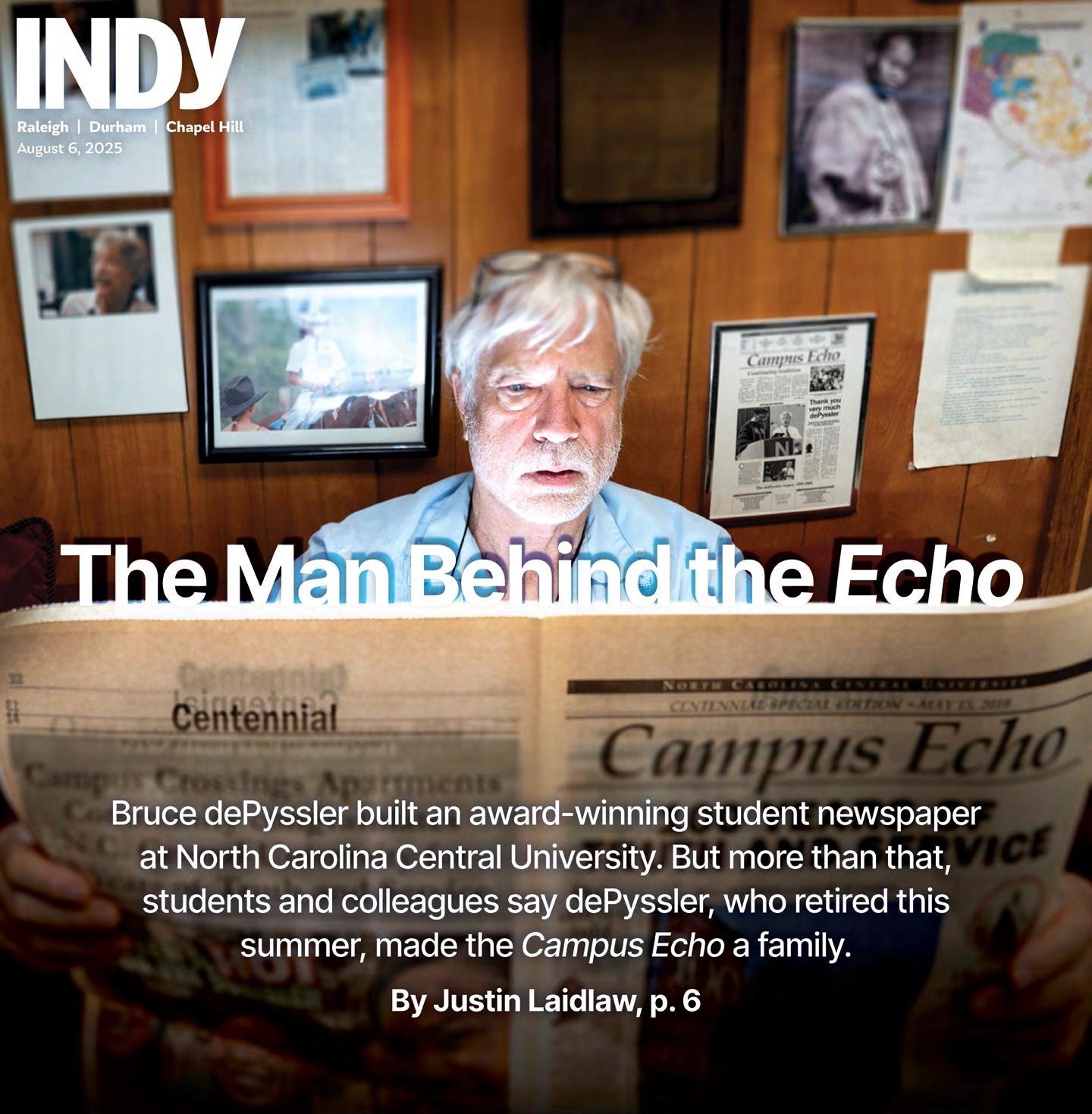

Raleigh W Durham W Chapel Hill
VOL. 42 NO. 15
6 Bruce dePyssler and his former students reflect on his 26 years at the helm of North Carolina Central University's student newspaper. BY JUSTIN LAIDLAW
10 A Doorway to Hope feeds families at a Cary mobile home park and fosters community for parents and kids alike. BY DANEEN KHAN
12 The city of Durham is studying the feasibility of a bus rapid transit system that would run from Duke to East Durham. BY JUSTIN LAIDLAW
14 Zebulon may be small, but its upcoming mayoral race is anything but boring. BY CHLOE COURTNEY BOHL
16 Duke University will start layoffs this week amid funding freezes and investigations by the Trump administration. BY CHASE PELLEGRINI DE PAUR
CULTURE
17 Lunch Money: A visit to Bee BanhMi in Cary. BY LENA GELLER
18 Talking with Hillsborough writer Libby Buck about her debut novel, Port Anna. BY SARAH EDWARDS
20 Highest 2 Lowest, Honey Don't, and more films playing in Triangle theaters this month. BY GLENN MCDONALD
21 Switchyards, a national coworking chain, opens its 28th location in Durham this month. It brands itself as a new kind of office away from home. BY LENA GELLER
23 Character Studies: “I’ve been called so many different things to try to pinpoint what exactly it is that I do," says emcee Kayla Knott. BY EVA FLOWE
3 Backtalk 4 Ask INDY 24 Culture calendar
COVER Bruce dePyssler poses for a portrait with the Campus Echo centennial edition on Monday, June 9, 2025, in Durham. PHOTO BY ANGELICA EDWARDS
Publisher John Hurld
Editorial
Editor-in-Chief
Sarah Willets
Raleigh
Editor
Jane Porter
Culture Editor
Sarah Edwards
Switchyards, a national coworking chain, opens its 28th location in Durham this month. (see story, p. 21).

Staff
Lena Geller
Justin Laidlaw
Chase Pellegrini de Paur
Report For America Corps Reporter
Chloe Courtney Bohl
Contributors
Mariana Fabian, Jasmine Gallup, Desmera Gatewood, Tasso Hartzog, Elliott Harrell, Brian Howe, Jordan Lawrence, Elim Lee, Glenn McDonald, Nick McGregor, Gabi Mendick, Cy Neff, Andrea Richards, Barry Yeoman
Copy Editor
Iza Wojciechowska
Editorial Interns
Eva Flowe, Daneen Khan
Creative
Creative Director
Nicole Pajor Moore
Staff Photographer Angelica Edwards
Advertising
Publisher John Hurld
Director of Revenue
Mathias Marchington
Director of Operations
Chelsey Koch
Account Representative
Jessica Schell
Circulation Berry Media Group
Membership/ subscriptions
John Hurld
Mathias Marchington
919-666-7229
support@indyweek.com
To reach INDY staff directly: tips@indyweek.com
PHOTO COURTESY OF SWITCHYARDS
B A C K TA L K
Last month, we published an op-ed from two UNC students highlighting the rising costs of groceries and calling on UNC-Chapel Hill to do more to address food insecurity on campus.
The school’s Media Relations Department sent the following response:
We appreciate the attention brought to this important issue; however, we would like to address some inaccuracies, highlight the work that is being done and request corrections where appropriate. Each instance of incorrect information is outlined below with the corresponding accurate information.
“UNC has taken small steps to address student hunger through promoting student-run initiatives like the Carolina Cupboard food pantry and limited emergency meal swipes. But these efforts, while well-intentioned, are Band-Aids on a gaping wound.”
UNC-Chapel Hill launched the Carolina Food Pantry Network (CFPN) in summer 2024. The CFPN showcases the many food security resources available to students and encompasses both University and student-facilitated resources. The Carolina Cupboard is one component of a network of pantries and food resources across campus, including those available in various schools and centers.
The meal swipe program, which will pilot in the 2025-2026 academic year, is not a student-run program; rather, it is supported by Carolina Dining Services and a student advocacy effort that was led by student government.
“The Carolina Cupboard’s offerings are mostly canned goods, inaccessible for students without kitchens, and the pantry is closed on weekends and breaks—when many students need it most.”
The CFPN Student and Academic Services Building (SASB) North location is operated in conjunction with the Carolina Cupboard. While all of the CFPN’s locations stock a variety of pantry staples, toiletry options, and some household supplies, the North location offers refrigerated and frozen products. The CFPN has many locations, with varying days and hours of operation to serve our students.
If students are experiencing food insecurity or know someone who is, they can submit a care referral form, supported by the Dean
of Students office. Students who need to visit the pantry outside of regular hours of operation can contact the Dean of Students office at dos@unc.edu and (919) 966-4042.
“This past semester’s announcement of a new meal-swipe donation program is promising, but limiting donations to one swipe per student falls short of the real need. If every undergrad donated one swipe, food-insecure students would receive only five swipes each—barely a week’s worth of meals.”
The meal swipe donation program is one component in a broader array of resources to address food insecurity across campus. These include free meals, a limited number of meal plans donated by Carolina Dining Services and distributed by Carolina Housing/ Student Affairs, and additional emergency meal vouchers that the Dean of Students and the Office of Scholarships and Student Aid distributes to students in need.
“Carolina Dining Services refused to allow recovered dining hall food to be redistributed through our fridge, prioritizing rigid partnerships over hungry students.”
CDS partners with the Food Recovery Network to donate surplus food from Top of Lenoir, Lenoir Mainstreet and Beach Cafe to both the Inter-Faith Council and Carolina Cupboard.
Eva Flowe wrote about Urban Ministries of Durham’s (UMD) efforts to serve a growing homeless population despite losing federal grants and fundraising revenue. A UMD board member called on Duke University to help fill funding gaps.
From reader GEORGE LUCACI by email:
Your recent, well-articulated, article highlighting the loss of two federal grants—totaling nearly $60,000—from FEMA and the USDA to the Urban Ministries of Durham (UMD) is a timely reminder of the precarious state of food security and homelessness in Durham. These challenges are not abstract statistics; they manifest in rising demand for meals, and increasing emergency shelter
waitlists for individuals and families.
While inflation continues to elevate the cost of essentials—eggs, milk, produce, and other staples—the philanthropic and institutional responses have not kept pace with the growing need. Duke University is Durham’s largest employer and a tax-exempt 501(c)(3) institution that, by some estimates, would owe between $50 million and $100 million annually in property taxes if it were not exempt.
The “Duke Respect Durham” campaign has urged the university to voluntarily contribute Payments In Lieu Of Taxes (PILOTs), a model adopted in many other university towns. However, Duke has yet to formally commit to this framework. The emphasis on “voluntary” contributions renders any such efforts both episodic and insufficient.
To be fair, Duke has made notable contributions during times of acute crisis and has recently started to up its game. The DukeDurham Fund, launched with $5 million during the COVID-19 pandemic, provided emergency assistance to nonprofits and small businesses. And the university has supported affordable housing initiatives, including a $22 million community deposit and partnerships with nonprofits such as the Durham Housing Authority. Duke has also enabled a $40 million federal housing grant, while directly contributing $1 million.
But context matters. These investments, while valuable, barely scratch the surface of Durham’s housing and food crises. A $1 million grant, however well-intended, is disproportionately small when considered alongside the university’s vast endowment—about $12 billion—(and its massive balance sheet with approximately $9 billion in revenue, including the medical center), and the scale of local need.
Duke initiatives like the recently formed Duke Center for Community Engagement offer promise, but there remains concern that Duke continues to define the terms of engagement without sufficient input from the communities most affected.
Community partnerships work best when they are mutual and accountable—not when they are top-down, strategic exercises in branding.
The other side of Duke’s track record includes its opposition to the regional light rail project, decisions that many believe have disadvantaged historically Black neighborhoods like Hayti, and a legacy of exclusionary land practices. These patterns reinforce a perception that the university engages with the city of Durham selectively, and only when it aligns with its own institutional goals in a
noblesse oblige framework.
The current moment demands more. Urban Ministries of Durham, like many local nonprofits, faces rising need, diminishing government support, and stagnant philanthropic inflows. Duke, as a privileged anchor institution, must decide whether it views itself as a good neighbor or merely an occasional good Samaritan. The distinction matters.
Durham does not need more tightly curated “transformational partnerships” that leave gaps in frontline services. It needs urgent, flexible, and community-led investment—especially as homelessness and food insecurity grow more acute. Timely and sufficient funding to organizations like UMD is not charity; it is a civic responsibility.
It is time for Duke to bring its rhetoric of engagement in line with transparent, sustained action.
Durham is watching—and waiting.
Back in June, Chase Pellegrini de Paur answered a reader question—for our regular Ask INDY feature—about how much Durham Public Schools funding is diverted to charter schools. The write-up continues to draw reactions from readers.
From reader LAUREN SARTAIN by email: Thanks to the INDY for their continued coverage of Durham Public Schools. In a recent Ask INDY, a reader wanted to know how many tax-payer dollars are diverted from public schools to charter schools. An important piece of the answer to that question depends on HOW MANY of the county’s students are enrolled in charter schools. Luckily, the state releases that information: 8 percent of Wake County and 12 percent of Guilford County school-aged children are enrolled in charter schools; in Durham, 26 percent or about 1 of every 4 children attend a charter school. That’s a remarkable and stark difference across those urban counties that are in relatively close geographic proximity and that face similar challenges from the state. You can’t blame Durham parents for opting out of public schools given confusion about how to enroll students in school and aftercare, no transparency around teacher and staff pay scales, nearly $1 billion in piled-up deferred building maintenance and construction costs, and cuts to bus services (all issues that the INDY and The 9th Street Journal have covered). Another noteworthy fact: four of the seven elected DPS Board of Education seats will be on the ballot in March 2026; the last school board election in March 2024 was largely uncontested, which is, unfortunately, a familiar trend in Durham County school board elections.
What Are Durham Date Ideas That Don’t Involve Alcohol?
BY SARAH EDWARDS sedwards@indyweek.com
This edition of our new Ask INDY column holds the distinction of being the first topic no one has submitted a question to. We take no offense: there is a lot more to ask of topics like, say, the Durham Public Schools system or Wake County transit. Scrolling back through Reddit, though, it is clear that dates—how to get them, what to do on them—is something plenty of locals wonder about. While I can’t help you on the former, below, find some thoughts on the latter. (Good luck out there!)
One of the most frequent date-night questions that surfaces on Reddit is: “What are Durham date ideas that don’t involve alcohol?” Here are some options.
Frozen treats
If you are going on a date circa now, you’re both going to be sweating. You might as well make seeking out something cold the organizing principle of your date. It’s a wholesome and relatively noncommittal activity, so it’s good for an early date.
Go classic and get cones at The Parlour and then walk around downtown, try Andia’s Ice Cream at the Can Opener (relatively private-feeling with plenty of food trucks to choose from), or get specific and grab ice cream sandwiches at Rose’s Noodles, Dumplings and Sweets, where standout flavors include white miso gingersnap
These stories are part of our ongoing series, Ask INDY, in which INDY staffers put their expertise (and impeccable taste) to use answering your questions about navigating life in the Triangle.
and berry–Key lime sorbet on vanilla graham crackers.
In my opinion—advice generally applicable to both ice cream sandwiches and dates—the more specific, the better.
If you’re looking for spots outside the downtown Durham core, walk to Pistachio in Lakewood or LocoPops near Ninth Street—the latter has a lovely screened porch that’s good for really settling into a chat. (LocoPops also has another iteration, LocoShop, off Foster Street.) For a bit more of a commitment, drive out to the dreamy Broken Spoke farm stand in Hillsborough for soft-serve on the weekends. You can bond with your date by trying to pet a goat or cow.
All right, so things are going well and eating ice cream can reasonably only take so long—what next? Depending on where you are in Durham, pop by a bookstore like Letters or the Regulator and browse (an activity that hits the perfect ratio between talking and silence), or walk to the Main Library downtown. Swoon!
Recreation
You can trust that this is objective journalism because I’m suggesting a category of activity (physical risk) that I probably would not enjoy doing on a date. But … many people do, so here goes. Go rock climbing at the Triangle Rock Club or the Durham Boulder Garden. Take a salsa dancing class at one of Durham’s many dance studios or at the weekly Sunday Salsa Social. A walk or picnic at Duke Gardens is a classic; you could also go to the Museum of Life and Science’s genuinely enchanting Butterfly House. Go roller-skating at Wheels and recover with slices of pizza. Stock up on quarters and show off your Mario Kart skills at Boxcar Bar + Arcade, High Dive, or Bowlero. Bike or blade the American Tobacco Trail. OK, I might’ve persuaded myself—these all sound like fun.
Art
Each third Friday of the month, downtown Durham hosts an art walk. Galleries throw open their doors for browsing, and usually there’s some kind of music happening outdoors. It’s a lovely way to roam, people watch, support local arts, and perhaps grab a bite to eat afterward.
The Nasher Museum of Art and the North Carolina Museum of Art both occasionally have special evening hours (romantic!) but also are a good activity at any hour; you can have a coffee at the museum café afterward. Downtown, 21c also has a collection that’s fun to wander (check out our list of summer exhibitions across the Triangle at indyweek.com). For a more hands-on activity, take a class at the Durham Arts Council or Claymakers, or go to Chapel Hill for one of Triple Spring Studio’s many class options (candlemaking, wooden spoons, mosaics!).
Hyperspecific events
“Let’s hang out” is the death of romance; “Let’s learn to play mah jong” or “Let’s go to the Nic Cage Film Discussion Group”— both regular events hosted by the Durham County Library (DCL) System—are the birth (maybe) of romance. You can find events like these on the DCL website or Discover Durham; of course, I’d also be remiss not to plug our weekly INDY Selects series that highlights five unique local events each week.
The Carolina Theatre has frequent events and special series, like its ongoing Retro Film Series, and there are always unique events at places like Mettlesome, Shadowbox Studio, the Pinhook, and Motorco Music Hall.
Unlike getting ice cream, committing to a structured activity does have a higher buy-in threshold. But that’s okay! In an age of relational evasion, a bit of buy-in is healthy; whether you’ve known each other for 20 years or 20 minutes.
What Are Some Free Indoor Activities for Toddlers?
BY JANE PORTER
This week’s Ask INDY topic is parenting during summer in the Triangle. One reader asks: What free things can I do indoors with toddlers? We do library story time and the museums, but we’re running out of ideas.
Exploring the museums (especially the NC Museum of Natural Sciences) and attending story time at the public libraries are indeed great, free options, but I totally agree—there’s only so many times you can wander the butterfly room or drop in on the dueling dinosaurs.
Not to mention it’s 100 degrees outside and while the local parks and playgrounds are fantastic, I’m personally not going back to one without a pumpkin spice latte in hand.
Cue the indoor activities!
Many of Raleigh’s community centers offer specialized programming for preschoolers, ranging from scavenger hunts

Historic Yates Mill in Raleigh offers free tours. IMAGE COURTESY OF WAKE COUNTY
and tot time (think gym mats, parachutes, riding toys, jump ropes, and crawl-through tunnels) to play-and-learn sessions with arts and crafts, music, and more. The kids get to socialize and get their energy out, and you get to chill, mostly, in the air conditioning. Check community centers near you for dates and times.
Lots of indoor spaces across Wake County offer free, self-guided tours, and toddlers have as many rights to be there as the rest of us. When my kids were toddlers, I took them to the State Capitol Building downtown, the Historic Mill Building at Yates Mill Historic Park, and the buildings at Historic Oak View. You could also try Haywood Hall and, when it reopens, the Pope House.
Other free indoor things to do around the Triangle: watch a free movie screening at the Halle Cultural Arts Center in Apex on a Wednesday morning; take a self-guided tour of Videri Chocolate Factory; or visit the Stone Houses at Dix Park.
If you’re all out of options, head to the mall. Crabtree Valley was my go-to, where summer mornings were quiet and my toddlers could wander, cool, safe, and contained. But I’ve heard from other parents that the kids’ play area at Triangle Town Center on the lower level near Dillard’s, is the way to go. Designed for babies and preschoolers, there are soft play pieces, play panels on the walls, and benches around the perimeter for parents. For Durham folks, the Streets at Southpoint has something similar.
Overall, I think there’s a shortage of free indoor activities for toddlers across the Triangle, something that’s glaringly apparent in these scorching summer months. Some of this may be related to programming cuts post-pandemic, some may just be underinvestment—but if you want to see more free indoor activities, let your local elected officials know; with our libraries and community centers, we have the space, and for all the families who live here, it’s definitely something to keep in mind when the next budget season rolls around. W


A new Ask INDY topic is posted bi-weekly. Send us your questions at indyweek.com/ask-indy or ask@indyweek.com.

















































































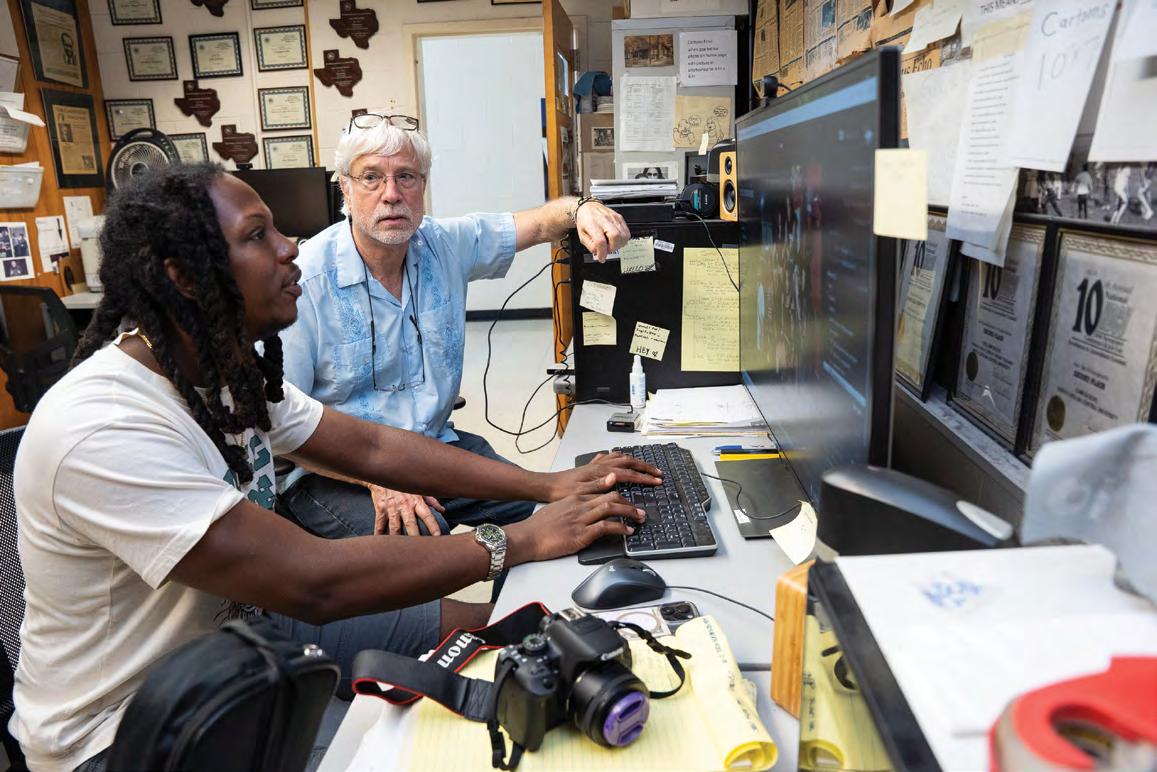
The Man Behind the Echo
Under Bruce dePyssler’s leadership, North Carolina Central University’s student newspaper went from having one computer to winning 300 awards. But more than that, students and colleagues say dePyssler, who retired this summer, made the Echo a family.
BY JUSTIN LAIDLAW jlaidlaw@indyweek.com
Plastered across the newsroom of the Campus Echo, the North Carolina Central University (NCCU) student newspaper, are a collection of laminated, yellowing editions of the paper, dozens of student journalism award plaques, and photos of former Echo staff on campus, at cookouts, and on team road trips. A sign at the top of the door reads “The Denita M. Smith Newsroom,” dedicated in honor of a former student who was tragically shot and killed.
During the school year, the Campus Echo, housed inside the Farrison-Newton Communications Building, is home base for aspiring writers, photographers, and video editors.
August 6, 2025 INDYweek.com
Each student is charged with narrating life at NCCU, in Durham, and at times, in the rest of the world—and leading the charge for the past 26 years has been NCCU professor and student adviser Bruce dePyssler.
A well-traveled “military brat” with a background in anthropology and a host of odd jobs, dePyssler has an innate ability to adopt new skills and meet people where they are. In the classroom, he was no drill sergeant. With his shaggy hair and glasses hanging around his neck, dePyssler would float through the classroom cool, calm, and collected, offering pearls of wisdom without overbearing.
Mike D, a senior at North Carolina Central University taking a summer photojournalism course, receives feedback on images from Bruce dePyssler, a journalism professor at NCCU and adviser of the Campus Echo student newspaper, on Monday, June 9, 2025, in Durham. DePyssler retired this summer after teaching for 26 years.
PHOTO BY ANGELICA EDWARDS
DePyssler not only built an award-winning program but shaped generations of students, including yours truly, who say “DP,” as he is affectionately called by the NCCU community, wasn’t just their professor but a father figure who made the Echo feel like home, and its staff like family.
After over two decades, dePyssler retired this summer and NCCU is trying to find a replacement.
“I’m not expecting anything less than Bruce,” says Calvin Hall, chair of NCCU’s Mass Communication Department. “Now we just got to figure out who’s going to build on the foundation that he laid.”
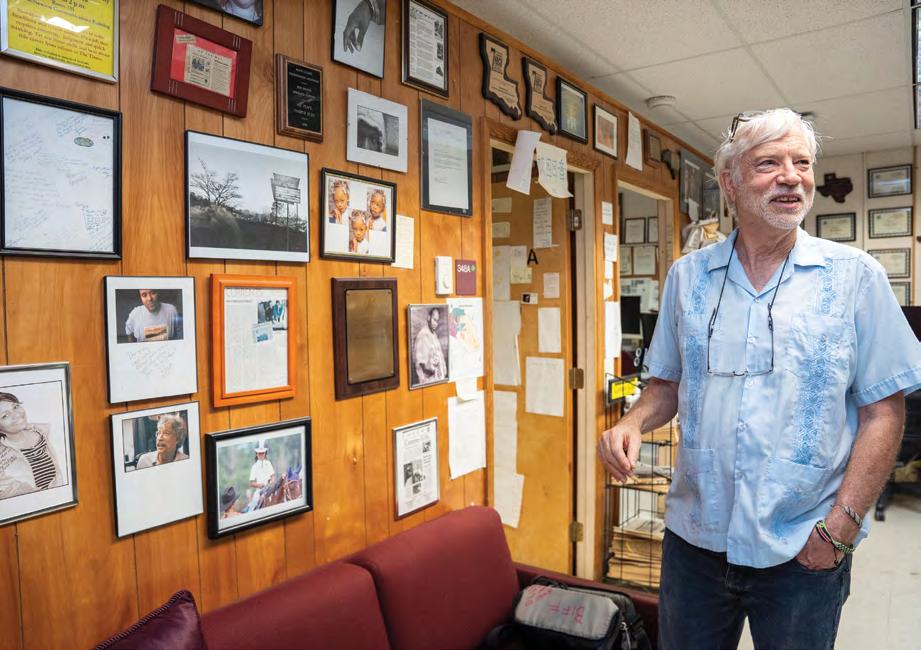
“Aren’t I supposed to be somewhere else?”
Before settling down at NCCU, dePyssler lived a nomadic lifestyle. His father, a U.S. Air Force colonel, took dePyssler around the world: California, Washington, Nebraska, Washington, D.C., North Dakota, the Philippines, and Puerto Rico.
“After a few years, I’d always go, aren’t I supposed to be somewhere else?” dePyssler says.
As a young adult, he maintained a variety of odd jobs like ice cream truck driver, janitor, and restaurant manager. He even followed a girlfriend home to France, where he worked on a tourist barge in the Canal de Bourgogne. The culmination of these experiences was a natural curiosity and adaptability—traits that would serve him well years later when he fell into a journalism career.
He planted roots in Texas in 1976, where he earned a double bachelor’s degree in history and philosophy, a master’s in communication and development, and a PhD in cultural anthropology, a fitting field of study for a globe-trotter. He taught communications, sociology, and anthropology at universities in Texas and Ohio.
DePyssler landed in Carrboro in 1994. His wife at the time, a communications researcher from Chihuahua, Mexico, got offered a job at UNC-Chapel Hill. DePyssler got hired as an adjunct professor and sought part-time work while finishing his dissertation. An ad for production help at an alt-weekly called The Independent, and its progressive bent, caught his attention. He nagged a manager enough times that they hired him on to help outline the paper.
“They’re cranking out the stories on the paper, and I’d run it through this waxing machine and stick it on these
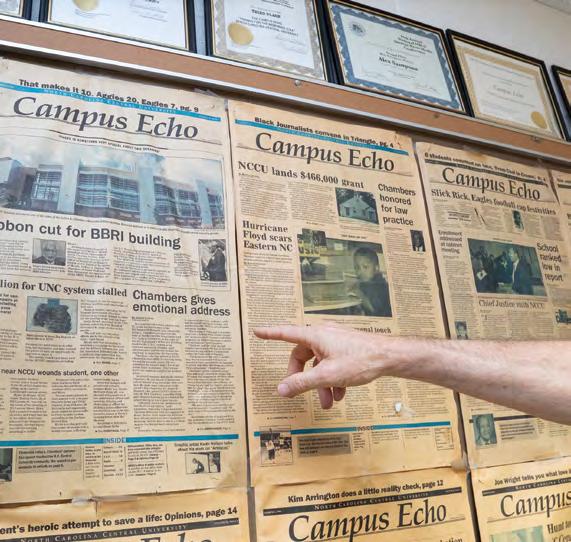
boards,” dePyssler says. “When it’s all done, I’d drive the boards down to the press. It was pretty substantial back then.”
Two years later, as he neared the end of his dissertation— on influential communications campaigns throughout Indian history—he was back on the job hunt. He applied for a teaching position at the University of the Incarnate Word in San Antonio, Texas. The administration saw that he worked at The Independent and inquired about him leading the school’s student newspaper, The Logos, too. Despite having a newspaper job on his résumé, dePyssler had never written more than a few articles, much less led a newsroom.
Steve Schewel, cofounder of The Independent, tried to convince dePyssler to stick around.
“Before I’m packing up,” dePyssler recalls, “Steve comes to me and says, ‘You know, you don’t have to leave. You can stay. We can keep working you here.’ And at that time, I’d written a few book reviews and stuff for the Indy, but I said, nah I’ll go.”
DePyssler liked living in the Triangle but was enticed by the challenge. He took the job in Texas and soon started to make his imprint on the newspaper program. Tricks of the trade, like AP style and how to construct a lede, were simple enough for dePyssler—used to a life of picking up odd jobs and new skills—to learn, and his background in anthropology and communications meant he understood people and how to tell a story. In a short time, The Logos was bringing home regional awards from the Society of Professional Journalists.
But the program also ruffled feathers with higher-ups. John Tedesco, now an editor at The Houston Chronicle, worked for the student newspaper dePyssler’s first year.
Tedesco’s stories on sexual misconduct by faculty and a university president busted trying to smuggle cigars out of Cuba caused a firestorm. Administration threatened to fire dePyssler, he recalls, but he stood his ground.
Soon after, another door opened for dePyssler. NCCU, an historically black university in Durham just 15 miles away from Carrboro, was searching for an adviser to lead the Campus Echo
The Dude
When dePyssler arrived in Durham in 1999, he made an immediate impression on his students. Before they ever learned about AP style, the students couldn’t help but notice their new professor’s own style.
“He used to wear these shirts and wear his sandals with his toes out and shit,” says Phonte Coleman, a musician and member of the hip-hop group Little Brother, who graduated from NCCU in 2001.
Coleman, an English major with a propensity for creative writing, found his way to the Campus Echo, where he became arts and entertainment editor. He likens dePyssler to “The Dude,” Jeff Bridges’s iconic character from the film The Big Lebowski
“He just seemed like that cool professor that probably smoked a lot of weed,” Coleman says. “My first impression was this dude is not your typical kind of buttoned-up, stodgy professor.”
Despite his laid-back demeanor, Coleman and others say dePyssler brought out the most in his students.
“He was a nurturing presence,” Coleman says. “He always
Left: Bruce dePyssler in the Campus Echo newsroom. Right: issues of the Campus Echo PHOTOS BY ANGELICA EDWARDS
looked out for all of us on the Echo. He went hard for us, and we went hard for him.”
Resources to produce the paper were limited in the early years. When dePyssler took over, “the Echo was zero,” he says. “It was nothing.”
A singular table that sat in the middle of the room bowed from the weight of the one desktop computer the program had, and there was no staff camera; whoever had their own camera was the photographer. Students worked lean and scrappy to produce the paper, developing their own film photography and dropping off the paper layout at the printing press themselves.
Those circumstances didn’t deter dePyssler or his students. Again, as he did at Incarnate Word, dePyssler quickly developed another award-winning program. Those early achievements gave him leverage to pressure the student affairs office for more resources. Advertising revenue started flowing, too. Soon, the Campus Echo could afford better computers and more cameras. The Echo’s growing reputation reverberated across campus.
Sheena Johnson Cooper, class of 2005, became interested in joining the Echo staff after a professor took notice of her writing skills and encouraged Cooper to further explore her talents.
“You heard those stories, and you walk in the Echo and you see the newspapers plastered on the wall, you see the awards plastered on the wall, and you just got this feeling like this is something special, and it just drew people in from all walks of life,” Cooper says. “Everybody has a story to tell, and the Echo was your playground to do it.”
But also like at Incarnate Word, the Echo under dePyssler’s guidance provoked the administration, and again, dePyssler
stood behind his staff and their reporting.
As a rare female sports reporter, Cooper spent hours interviewing players and coaches who referred to her with terms like “babe.” She says dePyssler encouraged her to lean into those challenges and be “powerful and unapologetic.” Together they confronted administration and coaching staff, and Cooper persuaded them to ensure student journalists were treated with respect while on assignment.
The Campus Echo came into conflict with university administration again years later while investigating the sudden departure of a vice chancellor at the school amid rumors and accusations. Echo reporters were stonewalled by administrators and school police at every turn.
“Regardless,” staff wrote at the time, “the Campus Echo will continue to search for the truth in every story.”
But perhaps the most significant clash was over Denita Smith, a former staff photographer who was shot and killed in 2007 by a woman described as a jealous ex-girlfriend of Smith’s fiancé. Rony Camille, who was the Echo editor at the time and had worked with Smith, led a campaign to name the newsroom in honor of Smith, but the administration pushed back.
“I remember DP spoke at Denita’s funeral on our behalf, and it was so beautiful,” Camille says. “I spoke at the memorial service on campus, and I made an announcement that we would be looking into renaming the newsroom after Denita. And there was a whole applause, but the administration was sitting in the front row and none of them applauded.”
Camille, with dePyssler’s support, rallied his peers to make the name change anyway.
Under dePyssler, the Campus Echo won a staggering
300 student journalism awards. DePyssler and Echo staff launched the Bull City Doc Squad, a rotating team of students who made films like Upbuilding Whitted, which was pivotal in bringing attention to the historical significance— and desrepair—of Durham’s first high school for African American students. There wouldn’t be a Mass Communication Department at NCCU if not for the Echo, says Hall, the department chair.
Former staff—some of whom still return to the nest to support the next flock of Eagle reporters—have gone into teaching, public relations, community development, music, and yes, even local journalism, like Rashan Rucker, class of 2003, who won an Emmy Award in 2008 for documentary photography at the Detroit Free Press. And on July 12, dePyssler received one more distinction: Durham mayor (and fellow Eagle) Leonardo Williams proclaimed “Dr. Bruce J. dePyssler Day” during a Zoom call with more than 70 former students and colleagues brought together by the clarion call of their former adviser and surrogate father’s retirement.
“He built a powerhouse,” Camille told the INDY. “He built something that we can all look back and be proud of.”
A home away from home
In 2001, dePyssler, the newsroom dad, piled the Campus Echo family into a passenger van for a trip up to D.C. to visit the USA Today offices. The van was as lively as the Echo. Coleman was “doing his hip-hop thing,” as dePyssler describes it, and DP, students say, was driving with the lead foot of a taxi driver during rush hour.
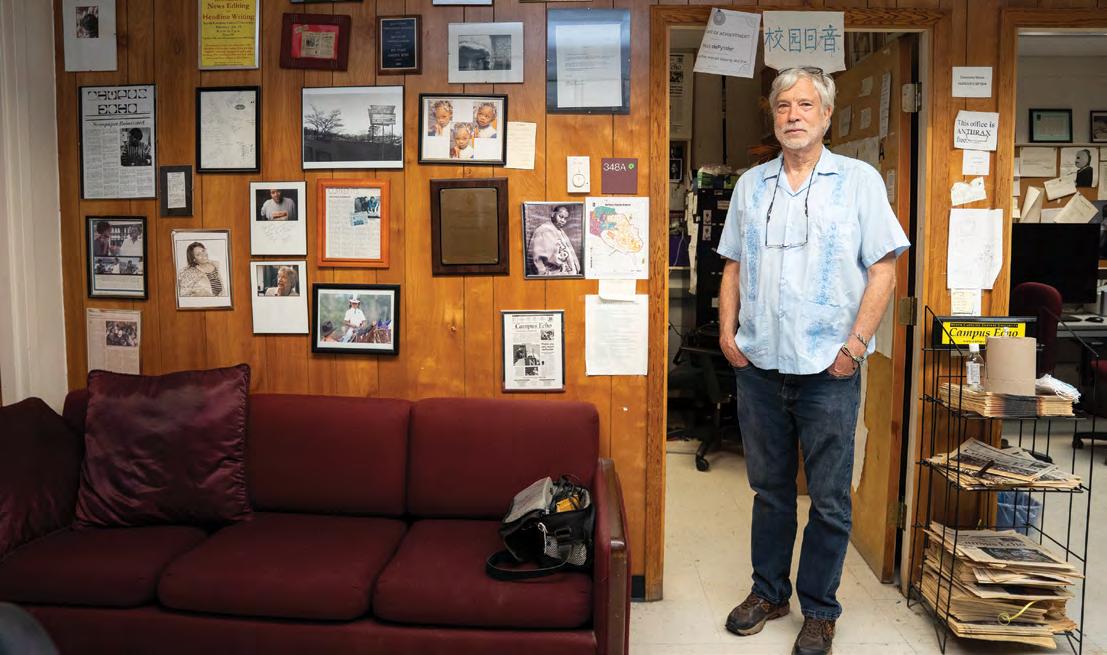
Bruce dePyssler PHOTO BY ANGELICA EDWARDS

Seeing USA Today was a shock for students who had so far only experienced the Echo newsroom.
“Walking through the newsroom,” Coleman says, “I was like, ‘This just seems really boring and really white.’”
Reporters sat in sterile cubicles, and there was no music playing over the PA. The visit crystallized a feeling dePyssler and the Echo students already knew: they had something special back in Durham.
Rarely was there a dull moment inside the Echo, especially in the first decade of dePyssler’s reign, before working remotely became common and the Echo still produced a physical paper. If staff weren’t in class, or asleep in the dorms, they were in the newsroom. Music was always in the air, either from students like Danny Hooley, who loved a good reggae tune, or from demo CDs that record labels sent for review. Reporters chipped away at stories or lounged in the room, laughing and joking about college life.
At the center of it all was the eccentric, mild-mannered, hippie anthropologist, DP, or, uh, his DP-ness, DP-er, or El DPerino if you’re not into that whole brevity thing
Students fed off the creative energy. Producing the paper was a team effort, especially on deadline. In addition to the daily happenings on NCCU’s campus, the Echo covered important cultural touchstones like 9/11 and the election of Barack Obama (the headline read “Obama Reaches Mountaintop.”)
Students say they never saw dePyssler lose his cool, apart from occasional frustration over deadlines. He was more “traffic cop than probation officer,” Coleman explains, providing guidance for student journalists to find their own way rather than imposing his own.
“He let us be who we are but we had guardrails, and the more comfortable we got with how who we were fit into this idea of putting out a news product, he would remove
“The Echo office was home away from home, the staff were like family, and DP was like Dad.”
the guardrails,” says Mike Williams, class of 2003 and former Echo editor.
As one of his many former jobs, dePyssler worked as a chain restaurant manager in Texas, a role that helped shape his leadership style years later at the Echo
“It’s a weird balancing act of giving people the room they need to do the job. You can’t be too heavy-handed. The thing in restaurants was always like, ‘Look, this is a bitch. I know it is. I didn’t invent capitalism. This is what we’re stuck with. Let’s do the best we can, and let’s enjoy ourselves.’”
Many former students say dePyssler was like a father figure to them. Students often brought in their kids; they weren’t allowed in class and childcare was financially prohibitive, so dePyssler opened up the Campus Echo as an unofficial daycare.
“The Echo office was home away from home, the staff were like family, and DP was like Dad,” Cooper says.
Keke, daughter of former student Stacey Hardin, class of 2005, grew up in the newsroom.
A photo of Keke beaming with joy during horseback riding lessons that dePyssler gifted her hangs right above his desk. He also taught Keke photography and supported her gymnastics lessons.
“We got attached, and I was kind of like a substitute dad for her for a while,” dePyssler says.
Another photo shows Coleman, his son—born while Coleman was a student at NCCU—and his son’s mother, a fellow Eagle, at a staff picnic. DePyssler was one of the first people Coleman shared the news about his son with.
The daycare tradition passed down through the years. Nada Merghani, class of 2023 and former editor, still saw rugrats running around the newsroom.
“A lot of that is DP’s doing,” Merghani says. “Even down to the name of the newsroom, the Denita M. Smith Newsroom, being named after a student who was so tragically
killed shows the level of care that, like, it was always all about the students.”
Some tough sandals to fill
Five years into his tenure at NCCU, dePyssler, the globe-trotter, flirted with taking a position at a small college in Lugano, Switzerland, teaching students “like Romney’s kids and the children of oil sheikhs,” dePyssler says. The school flew him to Switzerland for interviews and eventually offered him the job.
“When I came back, the students here were just going, ‘DP, you can’t leave, man.’ That was the closest I came to leaving. That was a tough decision.”
He devoted the next two decades to the Echo and its staff, cementing his legacy in the annals of NCCU history.
“I mean, he stopped wearing sandals a long time ago, thank God, but those are some tough sandals to fill,” says Hooley, a colleague of dePyssler’s in the Mass Communication Department since 2014.
DePyssler’s successor will have to make tough decisions about what direction to take the program and how to train students for an ever-changing industry facing challenges the Echo also faces, like artificial intelligence, fractured audiences, and a glut of information and entertainment options.
“How do we interest students in what journalism has to offer as a profession, and then how do we deal with the challenge or opportunity, depending on how you look at it, of what AI means in terms of that job? Because there’s always going to be the responsibility that journalism has taken on as a profession to report and enlighten and inform the masses of people,” Hall says.
NCCU has narrowed down the search for dePyssler’s replacement but hasn’t yet filled the role.
DePyssler doesn’t have plans to slow down in retirement. He is refocusing on documentary work and already has his next assignment: a film about Adrian Maldonado Jr., a young queer Latino man running for city council in Salisbury. DePyssler also plans to spend more time in Sierra Leone, where his wife, Kadiatu, is from and where the couple plans to adopt three children, mentor young professionals, and produce a documentary about the country’s decade-long civil war.
“A lot of men really struggle with this, you know, their whole life is tied up with their work,” dePyssler says. “My father was a good example. He just kept volunteering at the base for like 40 years after retirement.”
For dePyssler, packing up the Echo office was like packing up the home your kids grew up in after you become an empty nester. He delayed the process, packing up a box or two and letting them sit for a week, contemplating what his next chapter might look like.
On his last day, he pulled keepsakes off the walls—old photos, notes from students, a letter from former NCCU chancellor Julius Chambers—and left most of the award plaques and old newspapers up for posterity. Sitting in the office alone, replaying the highlights in his mind as he soaked up his newsroom for the last time, tears slid down his face.
“That’s the first time I really got emotional,” dePyssler says. “I was just in there on my own, like, damn man, I spent a quarter of a century in here.” W
Bruce dePyssler PHOTO BY ANGELICA EDWARDS
Cary
Feeding the Soul
The Nourishing Our Neighbors initiative provides dinner during the summer months to children who typically receive free and reducedprice meals from their schools.
BY DANEEN KHAN backtalk@indyweek.com

It’s a scene you might expect to see at an elementary school playground: children eating at picnic tables before running toward the field, climbing a play set, or doodling with chalk on the pavement. But it’s a hot summer evening, the games are donated, and for some of the kids, the meals are the only thing they’ve had to eat all day.
The children are benefiting from Nourishing Our Neighbors, a food security program organized by the Cary-based nonprofit A Doorway to Hope (ADTH).
ADTH helps low-income families in need across southwest Wake County with food, clothing, and other volunteer initiatives. Nourishing Our Neighbors primarily serves families in Chatham Estates, a mobile home park near downtown Cary.
Maria Young, the founder and executive director of ADTH, says most of the children in Chatham Estates attend Mills Park Elementary School in Wake County, where they receive free and reduced-price meals during the academic year. ADTH ensures the food supply doesn’t stop when the final school bell rings.
Originally, Nourishing Our Neighbors used U.S. Department of Agriculture (USDA) grant funds given to Wake County that Young noticed other programs weren’t using. ADTH also partnered with a local church that would do back-end paperwork and organize meal reimbursements for past years.
But for this summer, Young says the person who helped handle the funding and reimbursement efforts had left Wake County. Instead of the USDA funds, Nourishing Our Neighbors now relies heavily on donations.
Under Young, Katie Oakley works to coordinate the summer sessions as ADTH’s food security team lead. Over the course of the program, she’s “fallen in love” with Chatham Estates and views it as a second home.
“Cary is often seen as an affluent town, but many people overlook the pockets of real need within it,” Oakley says. “Every community, no matter how prosperous it appears, has areas that could truly benefit from resources and caring volunteers.”
ADTH provides 100 meals “for 100 children,” Young explains, (although sometimes parents also eat) every night from Monday to Thursday, until August 21 when school starts back. Sometimes, there are enough leftovers for volunteers to hand out to hungry neighbors on the side of the street. On other days, the food is gone within 30 minutes.
The dinners are provided by Ruckus Pizza, Pasta, and Spirits, a Triangle-based restaurant chain. Every dinner follows nutritional guidelines to ensure nutritional balance, “as if this were a meal provided at a local school,” says Ruckus owner Phil Mastroianni.
Still, Mastroianni makes sure to provide a variety of meals throughout the summer to ensure the food is as delicious as it is healthy. He even brings ice cream on especially hot evenings.
“We know that sometimes this may be the only meal they have, so we really try to make sure that it has great nutritional value and is something that they like to eat,” he says.
Solguta Roblero and her three young daughters have been attending the Nourishing Our Neighbors distributions every day. The program helps her girls by providing them a place
not only to eat but to safely play after being home all day, Roblero tells me with some help from Young translating. Roblero has lived in Chatham Estates for the past decade, but she’s unsure how much longer she’ll be able to stay. The community was put up for sale in 2023 and remains on the market, leaving residents like her in a state of perpetual anxiety.
She’s been told to move, but there isn’t anywhere for her to go. Rent across Cary isn’t affordable for Roblero and relocating would likely require switching her daughters’ school away from Mills Park, which she says she absolutely doesn’t want to do.
“Every day we pray, every day,” she says.
Other families have already relocated. Endry Portillo drives herself and her two sons from Clayton to attend the distribution events.
Portillo used to live across the street from Chatham Estates in another mobile home community. Her sister-inlaw, who still lives in Chatham Estates, told Portillo about the meal distributions.
Portillo makes the drive because Nourishing Our Neighbors provides more than just meals. Her boys get outside, try new things, and meet friends. And it’s not just the kids having fun— parents also get a chance to unwind, talk, and distract themselves from things at home or in the news.
“I hope that they continue doing it, this program, because as Hispanics, it’s hard for us to go out right now with things that are happening in the world, but [we] come here and see we’re all the same, we’re all together,” Portillo says. “It’s great for us.”
Volunteers distribute dinners at Chatham Estates Mobile Park as part of the Nourishing Our Neighbors initiative. PHOTO COURTESY OF A DOORWAY TO HOPE


While Portillo unwinds with the other adults, volunteers hand out food and play with the children. Emma Hastings, a rising senior at North Carolina State University, helps through a partnership with ADTH and the NCSU swim team.
“The boys like to play with balls, like baseball, soccer. Like that, running around,” she says, pointing toward two older kids on the field. “The girls like to make jewelry. They make bracelets all the time.”
Hastings says she loves connecting with the Chatham Estates children. While some of the older kids speak English, she finds herself bonding with the younger ones, too.
“Even if they don’t even understand what you’re saying, they’re still adorable and they’re so nice,” she says, this time pausing to help a toddler find crayons to color with.
“I love them all.”
Hastings, Young, Oakley, and Mastroianni are just a few of the faces behind the initiative. In Young’s words, it takes a village of people who care about tackling food insecurity to make Nourishing Our Neighbors effective.
Young remains adamant that ADTH keeps the program alive because the nonprofit, its partners and volunteers, and the Chatham Estates community all feel its impact. She thinks that as Cary residents realize the number of food-insecure children living alongside them, they’ll want to help, too.
“It’s your neighbors,” she says. “Your children have gone to school with these children, and these families could use a little bit of a hand here. A lot of people will, you know, pitch in. W



The Chatham Estates Mobile Park PHOTOS COURTESY OF A DOORWAY TO HOPE
What’s All the Bus About?
The City of Durham is looking at the feasibility of a bus rapid transit system that would run from Duke to Wellons Village.
JUSTIN LAIDLAW jlaidlaw@indyweek.com
Durham’s Transportation Department wants to give one of the city’s busiest traffic corridors a major upgrade by developing its first Bus Rapid Transit (BRT) route. The proposed seven-mile route would run through much of central Durham and link a number of important destinations including: Duke Hospital and the Veterans Affairs (VA) Medical Center, Duke Central Campus, the Ninth Street shopping district, Brightleaf Square, the downtown Durham station, the main library downtown, Holton Career and Resource Center, and the Wellons Village shopping center in East Durham.
The project is in the predevelopment phase as the city begins to scope out the route and determine its feasibility. Residents can complete a survey on the city’s website to share feedback on their transit needs.
Bus Rapid Transit is a souped-up version of the bus system you’re already familiar with: it’s often described as a “rail-like service on rubber tires,” with enhanced buses, dedicated bus-only lanes, and more frequent service intended to make bus travel a more competitive alternative to driving. In regions like the Triangle that couldn’t get out of their own way to build rail projects, BRT is a less costly substitute that is easier to shift into gear.
Ridership through the proposed corridor is substantial. The existing route 3 bus stop at Wellons Village serves the second-highest number of passengers behind only the downtown Durham station. Overcrowding on route 3 and route 11, which travels to Duke Hospital and the VA, has been a challenge, even with the increase to 15-minute service frequency. The transportation department has already invested in more frequent bus service and committed to additional road improvements to meet the demand for those routes. A “mobility hub” at Wellons Village, which would serve as a secondary satellite station in East Durham and include restrooms and a customer information desk, is also in the planning pipeline.
“This is a really promising corridor,” says Sean Egan, the City of Durham’s transportation director.

Across the GoDurham system, about 75 percent of riders live in carless households. Public transit is their only source of reliable, cost-effective transportation to access jobs, health care, groceries, and education. BRT would allow passengers who rely on the bus as their primary mode of transportation a faster, more efficient means of traveling.
“How do we make it faster, more convenient, more reliable for folks, particularly those living in zero-car households, low-income, minority populations?” Egan says. The goal for the BRT route is to cut bus travel times in half. Think Speed but the bus shouldn’t explode if it doesn’t get from Brightleaf to the downtown library on time.
“How do we make it quick, reliable, and easy for them to get where they need to go?” Egan says.
In addition to a dedicated bus lane, the transportation department is looking at other road augmentation opportunities to ensure the project’s feasibility. Buses on the BRT line could receive preferential treatment with their own traffic light signals that would allow them to skip traffic and stay on time. Rerouting traffic away from railroad crossings, which can cause significant delays when trains are passing through town, is also on the table, but could require creating “contraflow” lanes on one-way streets like Gregson Street, where the buses would travel in their own lane going the opposite direction of car traffic.
The transportation department added three full-time employees and an additional $6 million from funds in the Durham County Transit Work Plan to develop and implement a BRT plan. Durham joins its Triangle neighbors who
have also started the installation process for a BRT system. Durham followed their blueprint when thinking about the most appropriate route to start with, Egan says.
“We really took a page out of the experience of our neighbors,” Egan says.
Last year, my colleague Chase Pellegrini de Paur reported on Chapel Hill’s efforts to create five miles of dedicated bus lane to support BRT through the town’s primary north–south corridor, which connects to UNC Hospital. And Wake County editor Jane Porter reported earlier this month that Raleigh’s extensive BRT project is finally underway, with Phase 1 also connecting riders to health-care facilities at WakeMed hospital.
“[Durham] mayor pro tem Mark-Anthony Middleton says the test of a truly great city is whether you can get where you need to go without a car,” Egan says. “He grew up in New York, so we’re not going to be New York anytime soon, but we’re focused on the sidewalks with the bond referendum, we’re focused on improved bicycle facilities, better bus service, better train service. We want Durham to be a place where you can get where you need to go without having a car. And so the BRT is a huge step forward in that work.”
The initial project development activities are funded locally. The transportation department is working with consultants to help determine the project’s federal funding potential through a program with the Federal Transit Administration (FTA) called Small Starts, which scores the project based on key factors like ridership volume, as well as population density and employment density along the
A rendering for the proposed Central Durham Bus Rapid Transit system COURTESY OF CITY OF DURHAM

route. Egan believes the project will score well in the process, but that’s no guarantee that the feds would back up the Brinks truck anytime soon. He also says the current administration is less eager to take on new projects and is more concerned about clearing the large backlog of projects that have already been approved for funding. The transportation department is already hedging their bets, should federal funding come as a slow drip, if at all. Egan says his team is working with local stakeholders to determine if the first phase of BRT could be locally funded as a proof of concept. Federal funding could then be used to expand the network to areas like 15-501, another major residential and commercial corridor, and possibly to Raleigh and Chapel Hill.
Funding isn’t the only hurdle. Durham will have to work with the North Carolina Department of Transportation, which hasn’t always gone smoothly, to make any signifi-
cant changes to the roadways that much of the potential BRT route falls on.
Still, transit enthusiasts are hopeful that these steps toward increased bus service, BRT or otherwise, could be a tipping point for making public transit a legit alternative to driving in Durham and the region.
“We see a pretty significant jump in ridership when we add frequency, so we expect that to continue as our existing riders make more use of the system,” Egan says. “As it becomes more and more competitive, more folks from across Durham are going to start saying, ‘Yeah, this transit is easy, it’s 10 times safer than driving, I don’t have to worry about parking, and I don’t have to fight with some of the other drivers who are not very courteous. I could just sit and have a podcast on or watch TikToks on my phone, and next thing I know, I’m at my destination.’ So we really want to focus on that ease of use, convenience, and travel time competitiveness.” W



Bus rapid transit would connect key areas in central Durham including Duke Hospital, downtown Durham and East Durham. IMAGE COURTESY OF CITY OF DURHAM
An overview of proposed bus service enhancements as part of a bus rapid transit project in central Durham. IMAGE COURTESY OF CITY OF DURHAM
Zebulon’s Municipal Government Meltdown: A Timeline
A

five-way mayoral race features an embattled incumbent, two sitting commissioners with citizen petitions demanding their resignation, and a former town manager who quit his job in protest. How did Zebulon get here?
BY CHLOE COURTNEY BOHL chloe@indyweek.com
The last time Zebulon elected a mayor, in 2021, it was about as sleepy an electoral cycle as you could imagine. The outgoing mayor had decided not to run again after 28 years in office. Glenn York, a town commissioner at the time, ran and won easily against an opponent who had no government experience. Out of 8,000 residents, only 558 voted.

Four years later, the tiny town in eastern Wake County is gearing up for a very different mayoral race.
For one thing, York is running for reelection despite a chorus of calls for his removal from office. About as many people have signed a petition to that effect as elected him four years ago.
For another, instead of one relatively weak opponent, York has four challengers this time around: two sitting town com-
missioners, one former commissioner, and a former town manager.
Combine the crowded field with the fact that Zebulon has added 2,000 new residents since the last mayoral election, and this race has the potential to be the most competitive in recent town history.
But why are people calling for York’s resignation, and why are so many candidates jostling to replace him? Residents of Zebulon have been complaining about their town board of commissioners, which includes the mayor, for months. They’ve pointed to staffing vacancies, questionable hires, a lawsuit, and sudden resignations within town government as evidence that the board is untrustworthy or even corrupt.



Below, a crash course on the municipal government meltdown in Zebulon.

April 17, 2025
Todd resigns after four months. To fi ll his vacancy, the board appoints Jaiyeoba as interim town manager for a second time.

During a work session, Todd addressed the mayor and board: “Recent developments involving a serious personnel matter have led me to a point where I can no longer continue in this role,” he said. “I was placed in a position where I was expected to take action that I believe is unethical and inappropriate according to NC general statutes.”
Todd said he was resigning effective immediately and walked out of the room. That day, he didn’t offer any further explanation of the “personnel matter” that was the impetus for his resignation.
The board again appointed Jaiyeoba to serve as interim town manager.




December 19, 2024
The town board hires Gilbert Todd as town manager.
Todd was working in the town’s public works department before he was elevated to the manager job, WRAL reported.




June 3, 2024
Town manager Joe Moore resigns.



Per ABC11’s reporting, Moore served for nine years and the board accepted his resignation in a closed session. No public reason was given for the resignation.

July 2, 2024
Developers sue the Town of Zebulon over a rezoning rejection, alleging commissioners had conflicts of interest.
In May 2024, Zebulon town staff recommended the board approve Deacon Development Group’s proposal to build a 320-unit housing development called Zebulon South near downtown, but the board rejected it in a 4–1 vote.
Deacon’s lawsuit alleges the rejection was arbitrary and illegal, with the developers claiming that multiple town commissioners had undisclosed personal reasons for voting against the proposal.
June 4, 2024

The town board hires Taiwo Jaiyeoba to replace Moore on an interim basis. The vote was unanimous, according to meeting minutes. Jaiyeoba had recently resigned as city manager of Greensboro following a workplace sexual harassment investigation and a separate incident of alleged domestic violence.

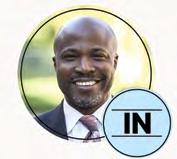



Commissioner Shannon Baxter voted “no” for fear that the development would negatively impact her beekeeping business, Baxter’s Bees, the complaint alleged, per WUNC.
Baxter told WUNC “that ‘bee colonies in urban settings do very well’ and it’s a ‘non-issue’ for the property in question.”
Also in the complaint: Commissioner Quentin Miles allegedly “made racially and sexually charged statements about [Deacon’s] counsel” during the rezoning application process “and indicated because he dislikes her, he would not approve any projects in which she represents the applicant.”
Miles did not respond to a request for comment. A jury trial is scheduled for November.

April 21, 2025
Assistant town manager Kellianne Williams resigns; Todd says the board had asked him to place Williams on leave without cause.

WRAL reported that Todd said he was “given a directive by the Board of Commissioners to place the Assistant Town Manager on Administrative Leave with no grounds to do so.” Todd told WRAL that Williams was an “exemplary employee” and he decided to resign rather than put her on leave.
The commissioners and Todd are legally barred from discussing the specifics of Williams’s work performance, but commissioner Shannon Baxter told WRAL that “the board never asked [Todd] to operate outside of his contract.”

And that just about brings us up to the present day. A few other noteworthy developments from this summer: a group called Move Zebulon Forward created a website in May encouraging people to vote and promising to convene community discussions about the upcoming election.
Another group, the Zebulon Citizens
April 28, 2025
Zebulon residents launch a petition to replace the entire town board.
The petitioners asked commissioners who are not up for election this fall—Baxter, Amber Davis, and Jessica Harrison—to resign by June 2 so a special election to choose their replacements could be held concurrently with the regular November 4 municipal election and every sitting commissioner could be replaced.


If Baxter, Davis, and Harrison did not resign (which they have not), the petitioners urged York to remove them “for just cause,” citing the rejection of the Zebulon South rezoning application, Moore’s and Todd’s resignations, Jaiyeoba’s appointments, the board’s “failure to fill the Town Clerk position for more than two years, impacting transparency and operations,” and the resulting backlog of missing public meeting minutes.
“This is a genuine grassroots movement born from deep dissatisfaction with the current state of town governance,” the petitioners wrote. “Each signature is a clear message to the Board of Commissioners that the widespread erosion of public trust is a crisis that demands immediate and decisive action.”
The petition has collected 423 signatures.


June 2, 2025
Commissioner Beverly Clark resigns.

Before tendering her resignation, Clark stood up during a board meeting and declared she had signed the petition calling for the board’s removal. She said a group of her colleagues had formed a voting bloc to effectively block her from getting anything done: “I can hardly get a motion seconded, much less approved by the board, no matter how good it is for the people,” she said.
“There is no doubt in my mind that this board is not interested in what’s best for the people, but are mainly interested in their own power, promoting their own political careers, and using their elected platform to do it.”
She called on Baxter, Davis, and Harrison to resign and for the town to elect “a whole new board and mayor.”

June 30, 2025
Jessica Harrison launches her mayoral campaign.

July

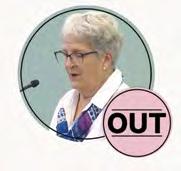

Advisory Partnership, formed on Facebook in June and began hosting community meetings about town government issues. As of July, 6,881 people are registered to vote in Zebulon. The candidates’ next campaign finance reporting deadline is September 30. Election day is November 4. W
16, 2025

Shannon Baxter and Larry Loucks join the mayoral race.
Baxter’s campaign website doesn’t mention the petition calling for her resignation. She writes on it that she can help Zebulon become “a quaint but robust town.”
Loucks is a former one-term commissioner who served 29 years on the town Board of Adjustment, 25 of them as chair. He does not appear to have a campaign website, but wrote on Facebook that he feels qualified to be mayor after his previous public service and 42 years spent in Zebulon. Loucks happens to be the only registered Republican in the race; the other candidates are registered Democrats.



July 15, 2025
Former commissioner Beverly Clark endorses Todd at his campaign launch party.


“I watched Gilbert when he stepped up to serve as town manager,” Clark said. “I saw his natural leadership and his deep care for the town. But it became clear that the board didn’t want an independent leader. They mistakenly believed that when they hired Gilbert, they hired a puppet to get the control they wanted …. Gilbert was asked to do something that wasn’t right, and he refused …. He chose principle over position.”
July 10, 2025
Todd announces he’s running for mayor.
His campaign website emphasizes a need to restore public trust in town leadership: “As your Mayor, I will aim to restore faith and integrity to our town government by championing three core principles: truth, transparency, and togetherness,” he writes.





Harrison did not acknowledge the upheaval in town government in her campaign announcement. Instead, she focused on the town’s rapid growth and promised to meet the moment with “steady, capable leadership.”








July 10, 2025
York quietly fi les for reelection.
The mayor does not appear to have a campaign website and has not responded to INDY’s interview requests.



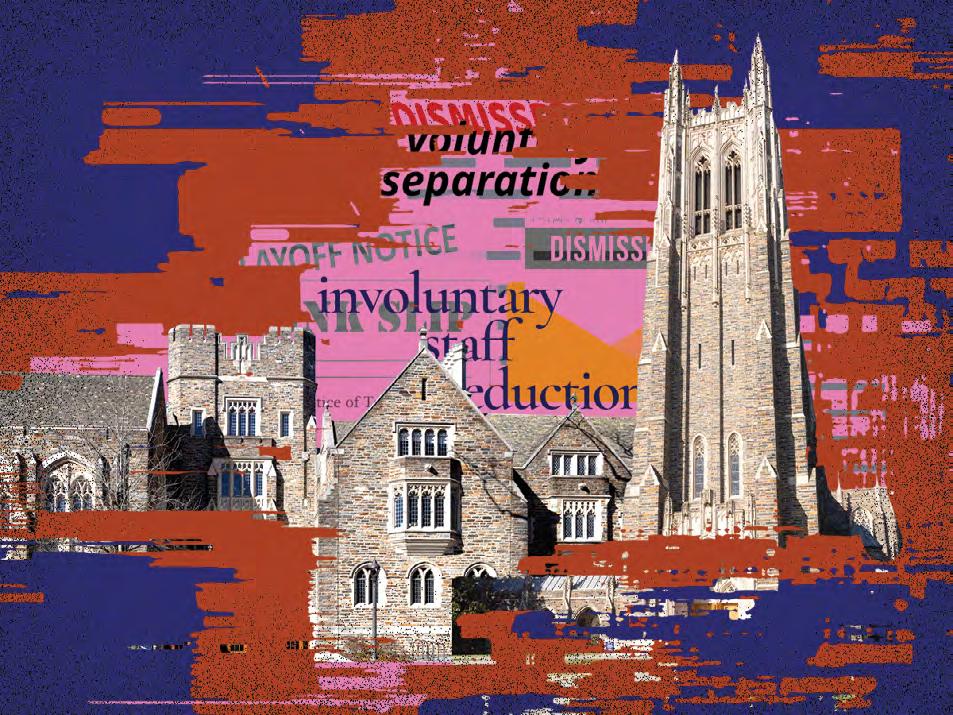
Fund Imbalance
As the Trump administration targets Duke University and its funding, the university announces it will start layoffs this month.
BY CHASE PELLEGRINI DE PAUR chase@indyweek.com
Duke University will begin layoffs as part of its plan to reduce costs amid federal funding cuts and mounting investigations by the Trump administration.
In a company-wide message on July 25, officials said that 599 employees had accepted “voluntary separation” and warned that “involuntary staff reductions” (known among commoners as “layoffs”) are coming this month.
“This news weighs heavily on all of us at Duke,” said the message that broke the news to employees. “Between August 5th and 19th, impacted employees will be contacted individually by their managers and will work closely with Human Resources through this transition. We recognize and are sorry for the impact these changes will have on our colleagues.”
The university didn’t detail how many employees it will
lay off to reach its goal but did note that “the high number of [voluntary separation] participants means that fewer employees will be affected by this action.”
The message, signed by Duke’s executive vice president and provost, noted that more than 250 additional faculty members are “currently considering” voluntary retirement incentives. It also doesn’t clarify if any departments or units had enough voluntary separations to avoid the impending layoffs.
Those who took the voluntary separation agreement, per a copy viewed by INDY, will receive a lump sum of two weeks of pay for each complete year of work at Duke, up to a maximum of a year’s pay. Those with less than three years of work will receive six weeks of pay. The agreement also requires that employees not apply for any jobs at Duke
for the next three years.
Duke announced in April that it would be cutting 10 percent, or about $350 million, from its budget as the Trump administration slashed research funding and threatened other cuts. Officials said that target was based on projections that the federal funding cuts and policy changes (including tiered tax rates on college endowments) could result in losses of as much as $500 million to $750 million. With more than 44,500 full-time and part-time employees between the university and its health system, Duke is the largest employer in Durham County and the second largest private employer in the state. It paid $4 billion in salaries and wages in 2024.
While Duke’s plan to cut costs was already underway, the Trump administration has turned the heat up on Duke in recent weeks. The Wall Street Journal reported in July that Duke is one of the schools from which the White House is seeking to collect a fine for failing to “stop antisemitism” on campus. Per the blueprint of Columbia University’s $200 million kowtow, an agreement with the Trump administration would presumably include a restoration of federal grants. And just last week, Trump’s Department of Education announced an investigation into Duke and the Duke Law Journal for possibly favoring students who reference their race or ethnicity in their application to the journal.
The Trump administration also froze $108 million in federal funding for Duke Health. The Department of Health and Human Services sent a letter to the university demanding that it “review all policies and practices at Duke Health for the illegal use of race preferences” and “take immediate action to reform all of those that unlawfully take account of race or ethnicity to bestow benefits or advantages.” W
Matt Hartman and Erin Gretzinger contributed additional reporting.
ILLUSTRATION BY NICOLE PAJOR MOORE, IMAGES SOURCED
FOOD & DRINK
Sweet Service and Spicy Fries at Bee BanhMi
A banh mi sandwich, fries, and Thai tea at a casual Vietnamese restaurant in Cary
BY LENA GELLER lgeller@indyweek.com
This story is part of a column, Lunch Money, in which staff writer Lena Geller visits restaurants in the Triangle in an attempt to dine out for less than $15.
I’m initially skeptical of the large banner that says “WE ARE OPEN TO SERVE YOU!” strung from the front counter at Bee BanhMi, a casual Vietnamese spot in a Cary strip mall, because the ordering situation is self-service. There’s a giant touch screen and no employees in sight.
Right when I step up to the screen, though, an employee pops out of the kitchen and offers help if I need it. This turns out to be the first of many well-timed appearances.
In this case, I’m good on my own—the menu is free of the usual digital ordering pitfalls. There aren’t endless subcategories or glitchy modifiers, just apps (summer rolls, dumplings, and “soup for the soul,” all available vegetarian), mains (pho, banh mi, bao, and stir-fried noodles, with a range of protein options), drinks (smoothies and teas), and the lunch special—a banh mi, a side, and a drink for $11—which practically orders itself. I choose pork as my protein, with fries and Thai tea. Then I type in my name and pay. With tax and tip, my total comes to $14.11.
Bee BanhMi has four booths, but they’re all full on the Friday afternoon I’m there, so
I claim a two-top beneath a framed illustration of a cartoon family clutching oversized banh mis. The space commits hard to the bee theme: honey-yellow walls, hexagonal floating shelves bearing plants in pots, and a corner mural of a dripping honeycomb.
There’s even a painted window—not a real window, but a hexagonal trompe l’oeil—depicting wildflower fields and distant mountains, golden honey oozing around its edges, as if we’re all bees peering out from inside the hive. The thoroughness of the theme reminds me of Webkinz, the virtual pet game particularly popular during Zoomer childhoods, where you buy themed furnishings for your pet’s virtual house. Bee BanhMi feels like what would happen if your pet was a bee and you blew all your KinzCash on the honey-themed furniture set.
The Friday lunch crowd is its own spectacle. Several groups that could be families or coworkers chat animatedly over their meals. At one booth, a couple sits side by side, deep in conversation; at another, two people face one another, each absorbed in their phones. Solo diners and folks waiting for takeout orders populate the remaining tables: there’s a girl with a mullet and a
T-shirt that says “Real Women Drink Big Beer”; a man tilting his head back to drain the last of his pho while talking to a friend on speakerphone; and someone sporting a full face of crimson face paint who likely just came from GalaxyCon down the road.
My meal is delivered in a tray lined with yellow-and-white checkered paper, with a compliment from the food runner: “I like your name.” The banh mi is a beauty. Sweet twists of tender pork, marinated in local honey, are nestled under whole cilantro leaves, shredded carrots, and jalapeño sliced long on the diagonal. A row of cucumbers tucked between the bread and the pork keeps the bread from getting soggy. The bread itself is thick and fluffy, with an exterior that crackles.
The fries are heavily seasoned with a warm red-and-orange spice blend and come with a plastic ramekin of just-as-heavily seasoned sauce. I find myself alternating, bite for bite, between fries and bites of sandwich, as the cool vegetables in the sandwich become counterpoints to the intensity of the fries.
When the five-spice starts to overwhelm my palate, I switch to dipping my fries in







the table sriracha, which builds heat until I’m eager for a glass of water. (The Thai tea, which is less sweet than I was expecting, accompanies the meal nicely, but sometimes you just need water.)
I stand up and barely have time to look around before someone appears next to me. “Water?” she asks, already extending a Styrofoam cup and pointing toward the beverage station.
For a place that starts you off with a touch screen, the human touches never stop coming. A few minutes later, I see the same person—the owner, I realize—bringing an extra-leafy bowl of pho to a woman who’s sitting in a booth on her laptop. “You love cilantro, right?” the owner asks. The woman, presumably a regular, smiles and nods. When I go five minutes without taking a bite of my food, an employee approaches, makes sure everything tastes OK, then provides a to-go box and a recommendation for next time (the stir-fried noodles). While boxing up my leftovers, I notice the checkered paper lining my tray looks just like the red gingham border we use on Lunch Money photos—as if Bee BanhMi somehow anticipated even our publication’s design needs. W
The lunch combo at Bee BanhMi PHOTO BY LENA GELLER
PA G E
True North
Hillsborough writer Libby Buck’s debut novel follows a woman who returns to her windswept Maine hometown to reckon with her past.
BY SARAH EDWARDS arts@indyweek.com

“All of a sudden,” Libby Buck says, “I had this image of a woman.”
Buck, a Hillsborough writer with a long red bob and impish Windsor glasses, is describing the moment that she envisioned Gwen, the main character in her debut novel, Port Anna, which was released by Simon & Schuster earlier this month.
Port Anna’s Gwen is a woman unmoored, as she leaves behind the boyfriend who dumped her and the Chapel Hill teaching job she was unjustly let go from, and heads toward her childhood home of Port Anna, Maine. There, the past awaits, embodied by a slew of old high school friends (mostly men), the ramshackle cottage she grew up in, the cottage’s pair of kindly ghosts, and memories of the sister she lost in childhood—a memory brought to the fore by posters of a missing girl, Shania, that pop up around Port Anna.
When that image of Gwen first came to her, Buck says, it was of the character crossing Maine’s real Piscataqua Bridge at one a.m.
“I was like, “What has happened to her?” That was where it started,” Buck recalls. “Then I started following the story of this woman and why she was in such terrible shape at the age of 40, and her life, and how everything’s been taken from her except for this little, tiny, unwinterized cottage.”
Buck may live in Hillsborough, but Port Anna, as she says, is a “love story” to her childhood home of Maine, with a love of the state’s lush landscape, in all of its quietly dra-
matic seasons, evident on every page. Gwen’s journey and the prose that matches it are introspective and wise—a gentle summer read, with a hometown romance unfolding across the pages as Gwen navigates grief, returning to both her home and herself, and figuring out how to pick up the pieces.
On the heels of the book’s publication, the INDY spoke with Buck about Maine, ghosts, and how the book came to life.
INDY: What’s your relationship to Maine like?
LIBBY BUCK: That’s a question that pretty much everyone asks, and it’s a very common one to ask if you’re in Maine, right? Everybody wants to know, “How long have you had a relationship with this? How many generations does it go back?” And seriously, if you’re not like, 18 generations in, you’re just not a Maine-r.
When I was seven, [my parents] bought a little cottage, very light Periwinkle, built by two women. We did call them “The Misses.” They were professors at Bryn Mawr, and the house was sold to us, lock, stock, and barrel, so we sort of adopted them as members of our family. I have a number of photographs that I show during my talks, of these women. They’re very tender. There’s a lot of touching; it’s very clear how much they loved each other. In their pictures, their friends came up, and they were all women. There are pictures of them swimming. They adopted kittens and
would carry the kittens around. They’re having tea on the outside porch. And anyway, it’s very sweet; we grew to love them.
There were also ghosts in the house—I never heard them, I think I was probably too young or unaware or oblivious. Evidently, my brother was the first one to hear them. He was a toddler, and one day during dinner, he looked to my mother and said, “Who’s upstairs?” And my mother was like, “Oh my god, there are footsteps up there, and nobody’s here but us.”
Ghosts usually have a negative connotation. But the ghosts in your book seem benevolent.
My experience of Maine in general is, I think of it as this magical, deeply spiritual space. It is a place where people talk about ghosts like they’re just next door, you know—“Oh yeah, that house is haunted.” Like everybody knows that. I had an experience not so long ago of having dinner with some friends at a very old cottage that’s right around the corner. It’s this ramshackle place, and people know work has been done on it for quite some time. I looked at the hostess, and I said, “Is there a ghost here?” And she goes, “Oh yeah, it’s Uncle George.” And at that very moment, the dog got up and went and stood at the bottom of the stairs and was looking up. Everybody just kind of accepts that they’re here and they’re not going to hurt anybody.
Port Anna author Libby Buck PHOTO BY GUNTHER CAMPINE
LIBBY BUCK: PORT ANNA Simon & Schuster | July 2025
Would you consider this a ghost novel?
No. I mean, they’re very present, but I was more interested in thinking about the things that haunt us, both to help us and to help guide us. My main character, Gwen, is metaphorically haunted as well by the loss of her sister. As painful as that is for her, it’s trauma that marks a life in indelible ways. I wanted to think about how you can heal from that kind of trauma and move forward. Sometimes those really difficult and painful things are teachers, too, and if we can embrace the lessons that they bring, there’s hope on the other side.
What was the nucleus of the story?
I wanted to write a love story to Maine, because I wanted to write about how much this place has meant to me over the years. My family had moved a great deal when I was growing up, and that little cottage was our touchstone. When we sold that house, it was heartbreaking—it was the middle of my parents’ divorce, and they couldn’t keep it. I wanted to write this love story, and my agent said, “That sounds like a great idea.” I was so excited about writing this that I
came back from my meeting and just started writing. Didn’t have an outline, I didn’t have a plan—which is a very bad idea, right? But once I started writing, I couldn’t stop. I was thinking about how much it meant to me to get here and the Herculean effort over the years, sometimes, to make it up I-95, and all of a sudden, I had this image of a woman. Her hair is prematurely white at the temples, and she’s got bags under her eyes, and she’s exhausted, and her life has fallen apart.
How does it feel to have the book out in the world?
I’ve had a lot of very sweet feedback from people, which makes me feel good. You know, when you write a book to make yourself happy, you don’t always know if it’s going to make someone else happy, too. So I’m just delighted when I get comments like, “I cried, I love this, I love Gwen, love The Misses.” It’s been really, really sweet. I had been warned that sometimes writers feel a letdown after pub day, but that has not been the case for me. W
This story has been edited and condensed for clarity. You can find the full interview online at indyweek.com.


INCOMING!
Incoming! Spike Lee, Ethan Coen, and Norwegian Sled Dogs
A 1963 crime drama gets an update, Margaret Qualley gets mixed up with a nefarious megachurch operation, and more films coming to theaters near you.
BY GLENN MCDONALD arts@indyweek.com
The winds of fortune are with us this month, evidently. Local theaters are bringing in a ton of interesting August movies—big, small, and in between Spike Lee returns to the big screen on August 22 with Highest 2 Lowest, an update of Akira Kurosawa’s 1963 crime drama High and Low. It gets even better: Lee is also reuniting with his favorite leading man, Denzel Washington, the world’s most charismatic human being.
The story follows record executive David King, who faces an increasingly dangerous moral dilemma when bad guys try to kidnap his son. What follows is a twisty and intricate procedural wrapped around the white-hot core of 21st-century New York City. Highest 2 Lowest premiered out of competition at this year’s Cannes film festival, with critics calling it one of Lee’s very best.
Also in the mix: Jeffrey Wright, Ilfenesh Hadera, ASAP Rocky, and Ice Spice in her film debut. The movie will roll out on Apple TV+ in September, but Spike Lee’s films are made to be seen in theaters. Do the right thing.
Another alpha-dog filmmaker returning to theaters this month, Ethan Coen is back with Honey Don’t, a crime-caper neo-noir in the same key as his last film, last year’s Drive-Away Dolls. The new film is the second installment in a planned “lesbian B-movie trilogy” from Coen and his co-writer Tricia Cooke.
The new film stars Margaret Qualley as Honey O’Donahue, a private investigator in California who gets mixed up with a nefarious megachurch operation. As with the previous series installment, Coen is clearly working in his dark comedy mode of eccentric characters and slapstick violence, powered this time around by a murder mystery plot engine.
LOCAL THEATERS

Chris Evans is on board as the libidinous pastor, with the never-not-great Aubrey Plaza as Honey’s love interest. Check the online trailers for a sense of things. It’s got that elusive Coen vibe. The filmmakers have also released promotional videos for two soundtrack songs by Qualley’s musical alter-ego, Lace Manhattan.
A third option this month for anyone looking to park their head somewhere else entirely: Folktales, an intriguing doc out of Norway, chronicles a high school program that pairs teens with sled dogs in a kind of Outward Bound wilderness curriculum. The kids have to rely on each other, and the dogs, just to survive the Arctic conditions. According to the educators, the idea is to counterprogram against phones and memes, and modern life itself by waking up the students’ Stone Age brains.
The movie won a lot of hearts at Sundance (and our very own Full Frame Documentary Festival!) and combines several appealing elements: hopeful coming-of-age narratives, the healing power of nature, dictionary-definition counterculture initiatives, and good ideas out of northern Europe. Plus, of course, dogs.
QUICK PICKS
Cat people, we’ve got you, too: Several local theaters have booked the annual CatVideoFest, a curated compilation of home videos, animations, and classic viral spots celebrating the feline spirit. A portion of ticket proceeds goes to local cats in need.
The annual OUTSOUTH Queer Film Festival returns to
the Carolina Theatre in Durham, August 14-17, featuring an assortment of shorts, documentaries, and feature films. Among the highlights, Sane Inside Insanity – The Phenomenon of Rocky Horror celebrates the 50th anniversary of everyone’s favorite rite-of-passage midnight movie. Madness takes its toll.
If you need a safe movie for date night or visiting relatives, the comedy-drama My Mother’s Wedding stars Scarlett Johansson, Sienna Miller, and Emily Beecham as three sisters who reunite for their mom’s latest nuptials. Writer-director Kristin Scott Thomas also plays the mom. Sydney Sweeney and Halsey star in the crime thriller Americana, a kind of neo-Western heist movie concerning the fate of a sacred Lakota ghost shirt. Bonus local trivia: Writer-director Tony Tost is an accomplished scholar and poet who finished his Ph.D. at Duke.
The mischievous U.K. indie Ebony and Ivory proposes a comedic version of a legendary real-life musical summit between Stevie Wonder and Paul McCartney. The gist: Remote Scottish retreat. Paul is blissed out. Stevie is not into it. Hijinks ensue.
Dakota Johnson headlines the indie comedy Splitsville, which explores the delights and hazards of an open marriage. This one got great reviews out of Cannes as a kind of hard-R update of the classic 1940s screwball comedy. Godzilla is enjoying a crazy run lately. Hardcore fans may want to hunt down Shin Godzilla, the highly acclaimed 2016 kaiju franchise entry, coming to North American theaters for the first time in the original Japanese (with subtitles) and a 4K digital remaster. W
Margaret Qualley as Honey O’Donahue in Honey Don’t PHOTO COURTESY OF FOCUS FEATURES
DURHAM SWITCHYARDS
733 Foster St., Durham | switchyards.com/durham-nc
Durham’s Newest Club Knows You Can’t Clock Out Anymore
Switchyards, a national coworking chain, opens its 28th location in Durham this month. It brands itself as a new kind of office away from home.
BY LENA GELLER lgeller@indyweek.com
At Switchyards, a workspace chain expanding to Durham next month, the coffee machines have touch screens that play a motivational video montage while your drink brews.
The montage is reminiscent of those infotainment clips that loop when you’re pumping gas, but instead of Maria Menounos reminding you to check your wiper fluid, there’s footage of dancers and rocket ships, overlaid with quotes like “You got out of your house for this.”
Got out of your house for what, you ask?
In the language of Switchyards: for the world’s first “neighborhood work club.” Not coworking space. The business is particular about this.
“We invented this damn thing,” the “About” section of the Switchyards website reads. “There was something we wanted that didn’t exist in the world. Essentially, we like working and meeting in coffee shops, libraries, and hotel lobbies. But we wanted all the things we love best about each to be under one roof. So, we made it.”
Switchyards doesn’t get into the nitty-gritty of what distinguishes a work club from a traditional coworking space. It touts walkability from surrounding neighborhoods, 24-hour access, and partnerships with local coffee roasters as key amenities, though these features don’t necessarily set

it apart from downtown Durham’s other shared workspaces.
But the distinction is telegraphed in how the company defines itself and in how hard a line it draws in the sand. If neighborhood work clubs like Switchyards—“the first of its kind, built for the way work is changing now”—are walkable hubs for people seeking single-origin caffeine and vampire hours, then coworking spaces are just old-school offices by a different name: places you drive to and count the hours until you leave.
The Durham Switchyards opens in early August at 733 Foster Street. A dry cleaning plant built in 1948, and a designated Brownfields site, the space is dominated by one main room—a soaring industrial expanse with at least 10 different kinds of seating, a skylight, exposed brick, and fake foliage out the wazoo. There’s also a conference room, a quiet study room, eight phone booths, a coffee and tea area, and “insanely fast Wi-Fi” (password: madewithsoul).
Durham memberships, capped at 250, went live on July 31. Switchyards’ creative director Brandon Hinman refers to this as “drop day.” Per a company email, the memberships sold out in less than three hours.
Coworking emerged in the early aughts as an antidote to the isolation of home offices and the drudgery of cubicle farms. Over the next decades, it grew into a mul-
tibillion-dollar industry, with WeWork as its energetic public face.
WeWork’s very public implosion in 2019, when the company’s failed attempt to go public exposed its financial woes, dampened the mood. But the coworking sector saw a boost as companies that went remote during the pandemic allowed employees to stay remote and everyone got a little stir crazy. In 2019, the United States had around 6,200 coworking spaces; by 2024, that number had jumped to 7,695.
While WeWork (which filed for bankruptcy in 2023 and has since restructured) remains one of the five largest coworking companies in the country, it’s no longer the aspirational model for the industry, and it increasingly serves companies looking to house office spaces rather than individuals seeking places to do remote work.
Here’s where Switchyards comes in. Work clubs, Switchyards suggests, are what coworking was supposed to be, before it became the thing it was meant to replace.
What most definitively sets Switchyards apart from the pack is its price point. At $100 a month for 24/7 access, the company undercuts all nearby competitors. American Underground charges twice that much for a round-the-clock monthly membership. Provident1898’s rates range
from $99 for 10 days a month to $249 for unlimited access. The WeWork inside One City Center starts at $160 for nine-tofive access. Orenge Durham comes closest at $70 for 10 days of monthly hot desk access, though only 10 hot desks are available; “dedicated desks” start at $225. At Switchyards, “there’s only one tier” of membership, Hinman says. “Whether you’re a billionaire or you’re between jobs, it’s the same.”
Soon after our interview starts, Hinman, who calls in from a padded phone booth inside one of Atlanta’s 12 Switchyards, delivers a version of a line that I’ve seen in every piece of Switchyards press: “We’re trying to take the best parts of a coffee shop, a college library, and a boutique hotel lobby, and smash them all together into one.” I ask him to elaborate.
“My favorite boutique hotel lobbies are generous,” Hinman says. “They have nicer furniture than I have in my house. They have a very thoughtful playlist going. The hand soap in the bathroom smells really good. I feel really sexy when I have a meeting there with a client or someone who I’m wanting to work with. And it’s open all the time.”
Switchyards launched in Atlanta in 2019. Michael Tavani, the company’s founder, went on to weather a 14-month pandemic closure and emerged to find his concept
The Durham location of Switchyards is located at 733 Foster Street PHOTO BY LENA GELLER

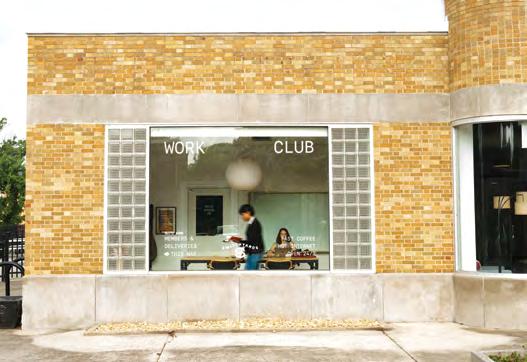
in explosive demand. In light of a $5 million investment from venture capital firm Bullpen last year, the company is aiming to grow to 200 clubs by 2029. It currently has 27 locations in eight states, 15 of which opened in the past year. Membership gets you access to all locations.
In mid-July, a “VIP First Look” event draws about 50 people—freelance writers and photographers, social media interns, small business owners and managers, developers building AI tools—who grab plastic cups of wine and wander.
Some test out the seating in the central space, which includes black vinyl banquettes, couches, solo workstations, twotop and four-top tables, and a tall communal wooden bench. Down the hall, others experiment with the phone booths (“It does feel like you’re in a fridge,” one person, exiting a booth, says to a friend), poke their heads in the conference room (“You think this jacket is a prop?” someone asks me, pointing to a tweed jacket on a coatrack), and tiptoe through the no-talking room, which is marked with a sign that
known colloquially as “the newsstand” when Hinman gets the room’s attention and begins a speech about the building’s bones. Its past life as a laundry facility inspired the green banner overhead that reads “Foremost,” he tells us.
“We dug into some old ads in newspapers, and there was one that said about the company, ‘Durham’s foremost cleaner,’” Hinman says. “I just thought, damn, I love that line—and I sort of don’t know what the word ‘foremost’ means. So it turns out, we looked it up and it’s a great word, and we made a custom banner there above the newsstand.”
Below “Foremost,” the banner also says “Dettagli e Pulizia,” which is Italian for “details and cleaning.” This is partly a reference to the fact that Tavani, the Switchyards founder, is half-Italian, and partly a reference to the importance of attention to detail at Switchyards.
Indeed, there are lots of touches, so to speak. Affixed to the wall behind the coffee bar, you’ll find local authenticity markers: a receipt from Everything Bagels, a business card from Little Bull, a toothpick from Little Bull, two signed Durham Bulls tickets, a photo of the sign outside Cameron Indoor Stadium. The same wall hosts depictions of noncontroversial political figures: a sketch of Abraham Lincoln, a painting of JFK, a photo of Princess Diana that’s been doctored so that her sweatshirt is emblazoned with the word “Switchyards.”
things start to break down is the company’s tendency to self-mythologize.
Page 1 of Club Paper’s second edition explains to readers that they’re witnessing the rebirth of the print news industry: “Newspapers are dying. But not this one. It’s just been born. And you’re holding it now in your arms… Welcome back to paper. You’re gonna love this new baby.”
Later, a page devoted to stroopwafels, the main food item that Switchyards stocks for members—and, for the record, a snack sold at every Target—defines the treat as a “Dutch wonder from the 18th century” before stating, in text wrapped around an image of a stroopwafel imprinted with the Switchyards “S,” “Fast forward to 2025. Switchyards buys them by the pallet.”
Another page shows two Switchyards-branded foam fingers with the caption “54 YEARS LATER, WE MADE ONE TOO”—a reference to the invention of the foam finger in 1971.
During his speech, even Hinman seems a bit fatigued by the creation trope. “We did invent this thing,” he says, of work clubs, “even though it pulls from some of the best parts of, like I said …” He trails off, refraining from repeating the boutique hotel lobby line a second time in the span of a minute. “And that’s exciting,” he says.
says “HEADS DOWN.”
The 20-odd attendees I talk to say they like the “schoolhouse vibe,” the natural light, the spaciousness. They like that it’s a way to meet people. (I run into someone from the event at a Superman showing, three days later.) They like the potential for “body doubling”—working alongside other people to help maintain focus.
“When you see other people doing their clicky clacky, it helps you get in your game,” one attendee tells me.
And they like the price. Many exclaim at the affordability. A few say it’s too pricey for themselves but still acknowledge that it’s a good deal, relative to other offerings. Everyone agrees on the coffee math: if you regularly do your work at coffee shops, you’re already spending $100 a month.
After a glass of Grüner Veltliner, I need to use the restroom, so I try opening a door that says “NOPE.” Turns out it is not a rejection of the gender binary, it’s just a locked door. (The real bathrooms, marked W.C., are gender neutral, just not so cheekily so.)
Back in the main space, I’m checking out the giant shelf of coffee table books
Scattered about are aesthetic anachronisms—VHS tapes, dictionaries, an old projector—and game items missing essential components: a rack of basketballs with no hoop, a plate of Boggle letters with no grid. More than anything else, there are world-building materials: Switchyards flags, Switchyards golf pencils, stacks of the quarterly Switchyards newspaper, Club Paper. Club Paper perhaps best encapsulates what’s both appealing and grating about the company.
The paper’s layout and design are beautiful. Inside, the member-generated content is engaging, with haikus (“Charger on the ground / Somebody’s laptop is dead / Hope they remember”), personal essays (“How Switchyards Became an Unexpected Refuge Post-Hurricane”), and get-to-knowyou blurbs (“I’m finally taking the time to learn about mushrooms”).
Some of the material doesn’t make sense for a newspaper that, per its own telling, is “read all over the world”: pages of classified ads, which Switchyards members can place for free, are mostly relevant for residents of Atlanta or Nashville. An article about a new wine bar in Poncey-Highland assumes the reader knows where Poncey-Highland is. But that stuff is still charming. Where
Hinman mentions there’s another reason for the Italian phrase on the banner overhead. Switchyards drew inspiration for its concept from “Italians’ healthy notion of third spaces,” he says—“places you go when you’re not at home or work, you’re just sort of coming through.”
Then, of Switchyards, he says: “This is a third space for work.”
A third space for work. As Hinman himself acknowledges, the point of a third place is that it’s neither home nor work. It’s the skate park, the bar, the barbershop, the dry cleaner’s, the library, the café, the hotel lobby. Third places can accommodate work, but they don’t exist for it.
Americans have always been bad at work-life balance, a partition that becomes more porous by the day. The United States stands out among the 21 richest countries in the world as the only to not guarantee paid vacation time or holidays. A 2025 survey assessing work-life balance in 60 countries—many of which, apparently, call it “life-work balance”—ranked the United States second worst, at 59, down several notches from last year.
Perhaps Switchyards has invented something: a monument to the collapse of the boundaries between work and leisure. The third place is dead. Long live the third place for work. Here’s your coffee. You got out of your house for this. W
Above: the interior of Durham Switchyards
PHOTO BY LENA GELLER
Right: the exterior of Durham Switchyards
PHOTO COURTESY OF SWITCHYARDS




All Dolled Up
Kƒes Character
BY EVA FLOWE arts@indyweek.com
ayla Knott has many ways to describe her work as a drag, burlesque, and cabaret emcee: Ringmaster of the titty circus. Wish.com Sabrina Carpenter. The MILF with the mic. The mother of dad jokes.
Professionally, though, Knott goes by Holly Pocket, a name inspired by the nostalgic, pastel Polly Pocket dolls from Mattel. As a performer, Knott considers her own act cabaret, without the striptease of traditional burlesque in her act, but she also has a drag character locked and loaded.
“His name is National Trevor,” Knott says. “He is from South Carolina. Great board shorts and one of those beer hats. We’ve all met Trevor, and I feel like I could really do something with that.”
Knott, who lives in Raleigh, has performed all over North Carolina but most often performs via her production company, Pocket Nightmare. She founded Pocket Nightmare in 2023 with another performer, who goes by Nicolette Nightmare.
Knott and Nicolette Nightmare originally did most of their performances at Ruby Deluxe, which closed in May. She says that while the Triangle scene is diverse, welcoming, and fun, the landscape is shifting—some venues have closed, either permanently or for remodeling, and she says there are more producers and performers than opportunities.
Common performance venues include Legends, Pinhook, Chapel of Bones, and The Fruit, and there are a variety of local performers and groups. For those looking to learn, the Raleigh School of Burlesque offers intensive classes, or “shimmy seminars.”






Kayla Knott goes by the name Holly Pocket for her work as a drag, burlesque, and cabaret emcee—a name inspired by the pastel Polly Pocket dolls.
AN INDY SERIES ABOUT FAMILIAR FACES AROUND THE TRIANGLE— AND THE STORIES YOU MAY NOT KNOW ABOUT THEM.
Though she considers herself a chameleon, matching the themes of the events she hosts, Knott’s own aesthetic has a Polly Pocket–like femininity. The burlesque performances the night of our interview at Chapel of Bones in Raleigh were 1980s hair metal themed, but Knott still wore sparkly, pink bow-shaped earrings along with her teased hair, blue eyeshadow, and fishnets.
Even so, she did the famous Napoleon Dynamite dance on stage while pregnant, is dressing as Austin Powers for an event this September, and stays open to new ideas.
“People have circled around how to define me for a long time,” says Knott, who has been an emcee for three years. “I’ve been called, like, so many different things to try to pinpoint what exactly it is that I do, but it’s really just dumb shit from a theater kid.”
A stay-at-home mother of three, Knott studied drama and psychology in college and briefly worked in mental health care. She says she brings those skills with her onto the stage.
“Improvising on stage during a show where things can go wrong, where things change really quickly,” Knott says. “Something that I feel like I bring to the table is I learned how to crisis manage, put my head down, move forward with a smile on my face.”
And Knott has had to crisis manage through a variety of challenges from her

place on stage, from wardrobe and set malfunctions to far-right provocateurs in the audience.
“I’m at the wheel of the boat,” Knott explains, “and all of the audience members are trying to get to a destination. And whatever happens during the show— waves, storms, dysentery, or whatever happens—I have to get the people to the place, so I will.”
Knott is a North Carolina girl, born and raised, and says she sometimes feels a little starstruck when performing at venues she looked up to as a child in Wake County. She recently hosted a showcase of burlesque through the decades at the Rialto Theater.
“It’s fun to be part of a community where I grew up and watched other people perform, especially performing at the Rialto when I was a theater kid and thought of the Rialto as a really cool, fancy place,” says Knott.
Knott loves to emcee because she is not only a performer but a fan of the performers she hypes up with a salacious dad joke or a cover of a thematic song.
“When we see [a performance] on stage, it’s a one-of-a-kind show,” says Knott. “It’s never gonna happen again. It’s the first time I’m seeing it, it’s the first time the other performers are seeing it, and it’s just, it’s a one-of-a-kind little art piece.”
Kayla Knott, who emcees as Holly Pocket PHOTO COURTESY OF THE SUBJECT
C U LT U R E C A L E N D A R
WED
8/6
MUSIC
Rob Thomas: The All Night Days Tour
7:30 p.m. Red Hat Amphitheater, Raleigh.
Waitress
August 6-24, various times. Theatre Raleigh Arts Center, Raleigh.
The Wiz August 5-10, various times. DPAC, Durham.
THUR
8/7
MUSIC
Blackberry Smoke, Mike Campbell & The Dirty Knobs, Shannon McNally
6 p.m. Red Hat Amphitheater, Raleigh.
Summer Jazz Jam with Butler Knowles
Thursdays at 7 p.m. Missy Lane’s Assembly Room, Durham.
STAGE
KING ME: An All Drag King Show 10 p.m. The Pinhook, Durham.
Raleigh Fringe Festival
Jul. 10-13, various times. Theatre Raleigh Arts Center, Raleigh.
FRI 8/8
MUSIC
Catharsis, Scarecrow, Cyprian
8 p.m. the Pinhook, Durham.
Chris Stamey Record Release Show
8 p.m. The ArtsCenter, Carrboro.
Come sing Chappell Roan and Fleetwood Mac with PopUp Chorus!
7:30 p.m. The Haw River Ballroom, Saxapahaw.
Eslabon Armado: Vibras de Noche II Tour
7 p.m. The Ritz, Raleigh.
High + Tight: A Lifetime of Soul, Funk, and Disco Fridays at 8 p.m. Wolfe & Porter, Raleigh.
Knockout Artist
6:30 p.m. Rubies on Five Points, Durham.
The Kobie Watkins Grouptet
7:30 p.m. Sharp 9 Gallery, Durham.
Let It Happen: Tame Impala Dance Party
8 p.m. Motorco Music Hall, Durham.
The Moon Unit x INSTANT ALTER
8 p.m. Cat’s Cradle Back Room, Carrboro.
RDU Live Playlist Concert: Curator’s Edition V2
7 p.m. Bond Brothers Eastside, Cary.
Scott Bradlee’s Postmodern Jukebox: Magic & Moonlight Tour
8 p.m. The Carolina Theatre, Durham.
SunSets Evening Rooftop DJ Sets!
7 p.m. The Velvet Hippo, Durham.
STAGE
Hadestown: Teen Edition
July 25-Aug 10, various times. Raleigh Little Theatre, Raleigh.
Hush Hush: Comedy Based on Secrets Fridays at 9 p.m. Mettlesome Theater, Durham.
SAT 8/9
MUSIC
Big Ocean
7 p.m. Fletcher Opera Theater, Raleigh.
The Chili Poppers
7 p.m. The Ritz, Raleigh. Durham Raga Revival
11 a.m. Carolina Theatre, Durham.
James Fernando Trio
7:30 p.m. Sharp 9 Gallery, Durham.
It’s a 2000s Party
8 p.m. Motorco Music Hall, Durham
Saturday Night Dance Party at The Velvet Hippo! 9:30 p.m. The Velvet Hippo, Durham.
Skating Polly
8 p.m. Cat’s Cradle Back Room, Carrboro.
Sonido Divino, Latin Night (18+)
11 p.m. Club ERA, Durham.

LIKE TO PLAN AHEAD?
Summer Concerts in the Park: Emma Jane & Tre.
Charles
6 p.m. Piney Wood Park, Durham.
STAGE
Last Podcast on the Left: JK Ultra Tour
8 p.m. Carolina Theatre, Durham.
PANIC! AT THE BURLESQUE SHOW
8 p.m. the Pinhook, Durham.
Thee Lion’s Den: An all trans cast of Dance & Burlesque with DJ Kali Fuchis
10:30 p.m. The Pinhook, Durham.
SUN 8/10
MUSIC
Crazy Chester: A Tribute to The Band
7:30 p.m. Rubies on Five Points, Durham.
East Forest
8 p.m. Haw River Ballroom, Saxapahaw.
Sunday Jazz Brunch curated by Al Strong
12 p.m. Missy Lane’s Assembly Room
PAGE
Flyleaf Poetry Series: Joan Barasovska, Joey Lew
2:30 p.m. Flyleaf Books, Chapel Hill.
MON 8/11
MUSIC
Chris Isaak
8 p.m. Carolina Theatre, Durham.

Part-Time Paradise performs at Rubies on August 15. PHOTO COURTESY OF RUBIES
Skating Polly performs at Cat’s Cradle on August 9. PHOTO COURTESY OF CAT’S CRADLE
FIND
TUES
8/12
MUSIC
Barrelhouse Blues: A Jook Joint Revue
Tuesdays at 7 p.m. Missy Lane’s Assembly Room, Durham.
Open Mic with a Band at Slim’s
Tuesdays at 9 p.m. Slim’s Downtown, Raleigh.
Soulful Sounds near Raleigh
6 p.m. Arise CoWorking, Raleigh.
PAGE
Silent Book Club at Letters
6 p.m. Letters Community Bookshop, Durham.
WED 8/13
MUSIC
Ally J on the Roof
7:30 p.m. The Durham Hotel, Durham.
The LGBTQ Youth Center of Durham Presents: YA QUEER SOCIAL!
6 p.m. the Pinhook, Durham.
THUR 8/14
MUSIC
Benches
8 p.m. Cat’s Cradle Back Room, Carrboro.
Deerest Friends, Post Office Winter, Charlie Paso, Nonsense
8 p.m. the Pinhook, Durham.

10.
Ed Stephenson: Flamenco Fusion
5:30 p.m. The Westin Raleigh-Durham, Raleigh.
Roland Burnot Quartet
7:30 p.m. Sharp 9 Gallery, Durham.
Summer Jazz Jam with Butler Knowles
Thursdays at 7 p.m. Missy Lane’s Assembly Room, Durham.
SCREEN
The Grateful Dead Movie Aug 14-15, various times. Marbles IMAX, Raleigh.
FRI 8/15
MUSIC
Femme Friday: Third Friday Dance Parties!
9:30 p.m. The Velvet Hippo, Durham.
Goodies : 2000s Hip Hop Nite
9 p.m. Motorco Music Hall, Durham.
High + Tight: A Lifetime of Soul, Funk, and Disco Fridays at 8 p.m. Wolfe & Porter, Raleigh.
Hotline TNT: Path of Totality 2025
8:30 p.m. Cat’s Cradle Back Room, Carrboro.
Part-Time Paradise
6:30 p.m. Rubies on Five Points, Durham.
SCREEN
Museum Movie Night: The Mummy
5:30 p.m. NC Museum of Natural Sciences, Raleigh.
SAT 8/16
MUSIC
AJJ, Pacing
7 p.m. Motorco Music Hall, Durham.
The Conjure Presents: The House of Blk August 10 p.m. the Pinhook, Durham.
The Red Clay Strays: Get Right Tour
7:00 p.m. Red Hat Amphitheater, Raleigh.
Saturday Night Dance Party at The Velvet Hippo! 9:30 p.m. The Velvet Hippo, Durham.
The Soul Picnic 2025
5 p.m. Koka Booth Amphitheatre, Cary.
THRIO
7:30 p.m. Sharp 9 Gallery, Durham.
verygently and Brother Elsey
8 p.m. Cat’s Cradle Back Room, Carrboro.


STAGE
Drag Story Hour With Stormy Daie
10 a.m. Carolina Theatre, Durham.
SUN 8/17
MUSIC
Kairos Creature Club
8 p.m. the Pinhook, Durham.
Taylor Sharp
6:30 p.m. Rubies on Five Points, Durham.
MON 8/18
MUSIC
Philip Bowen
7 p.m. Motorco Music Hall, Durham.
TUES 8/19
MUSIC
Barrelhouse Blues: A Jook Joint Revue Tuesdays at 7 p.m. Missy Lane’s Assembly Room, Durham.
Open Mic with a Band at Slim’s Tuesdays at 9 p.m. Slim’s Downtown, Raleigh.
Pearl
8 p.m. Cat’s Cradle Back Room, Carrboro.
Rob Magill, Laurent Estoppey, Daniel Levin
7 p.m. Shadowbox Studio, Durham.
East Forest performs at Haw River Ballroom on August
PHOTO COURTESY OF HAW RIVER BALLROOM
Ally J performs at The Durham Hotel on August 13. PHOTO COURTESY OF THE DURHAM HOTEL
Pearl performs at Cat’s Cradle on August 19. PHOTO COURTESY OF CAT’S CRADLE

CROSSWORD
Los Angeles Times Sunday Crossword Puzzle
Edited by Patti Varol


| DO | KU
There is really only one rule to Sudoku: Fill in the game board so that the numbers 1 through 9 occur exactly once in each row, column, and 3x3 box. The numbers can appear in any order and diagonals are not considered. Your initial game board will consist of several numbers that are already placed. Those numbers cannot be changed. Your goal is to fill in the empty squares following the simple rule above.

39 Wise men bearing gifts of formula, onesies, and diapers?
C L A S S I F I E D S
HEALTH & WELL BEING

REAL ESTATE
Charming Watts-Hillandale Home for Rent
This spacious 1,500-square-foot house in the desirable Watts-Hillandale neighborhood is available for rent. The home features a large bedroom on the main level, and upstairs, a flexible loft-style space with skylights plus an additional downstairs room that would be perfect as a small bedroom, office, or nursery. The house has two full bathrooms, a separate dining room, and a living room. It includes a washer and dryer in the basement, as well as a wired, freestanding two-car garage and a private, landscaped backyard.
Located just 1.5 miles from Duke East Campus and Duke Hospital, this home offers a great location. The rent is $2,950 per month, plus utilities. For more information, please contact Chris at SquirrelNestRealty@gmail.com.
Controls Technician (CT-SDM)
Controls Technician (CT-SDM). Perform mech adj work & elec installs (internal/external).
Dom & Intl travel reqd 65-70% of the time. Telecommuting permitted. Reqs BS+3 yrs rltd exp. Mail resumes to Syntegon Technology Services: HR Manager, 2440 Sumner Blvd., Raleigh, NC 27616. Must ref job title & code CT-SDM.
Financial Investment Advisor
Financial Investment Advisor (Cary, NC). Bach’s deg in finance or fin’l mgmt. 24 months of exp in fin’l mgmt position w/ fin’l or investment institutions. Hands-on exp in investment consulting or strategy planning. Excellent client relationship mgmt skills. Must be able to adhere to high standards of professionalism such as confidentiality. Apply to TRIANGLE ACCOUNTING, INC at 1601 Walnut St, Ste 201, Cary, NC 27511.
43 “Something To Talk About” singer
45 Want
46 Align properly
48 Beach, in Portuguese
50 Project ending?
EMPLOYMENT
51 Hershey rival
Lead Data Systems Engineer
54 Gaggle members
56 Filmmaker Spike
57 Some nobles
60 Blunted blade
61 RR connection
62 Skirt that shows off ankle boots
63 Draft choice
65 Monkeyshines
69 Dish made with Arborio rice
71 “That guy prefers more formal greetings”?
76 Ships abroad
77 Hit the hay
78 Office no.
79 Front or spot
80 Estadio “Rah!”
82 Lass
84 Argentine prairie
88 Succinct “I could go on”
89 Saw logs
91 Chaste
93 Bit of static buildup
94 Sister’s daughter
96 Gave faithfully?
Lead Data Systems Engineer, F/T at Truist Bank (Raleigh, NC) Provide consultation & tech’l direction on translating business reqmts & functional specs into logical prgm dsgns. Facilitate the implmtn & maintenance of complex business & enterprise s/ware solutions to ensure successful deployment of released applications. Support SIT & UAT for large, complex, crossfunctional application initiatives by providing insight to testing teams. Must have a Bach’s deg in Comp Sci, CIS, or related tech’l field. Must have 5 yrs of progressive exp in s/ware dvlpmt or IT infrastructure positions performing the following: MuleSoft Platform support; API Dvlpmt & Support; working on project(s) involving the implmtn of solutions applying dvlpmt life cycles (SLDC); dsgng & automating regular maintenance activities using Python & other scripting languages; writing tech’l documentation in a s/ware dvlpmt environment; working w/ Integration/ Deployment tools; working w/ source code control systems; ensuring infrastructure changes adhered to ITIL, & Change Mgmt, security access procedures & policies; assessing & testing infrastructure changes (service requests, automated incidents, & change mgmt) to evaluate business risk from a server, storage, n/work, & API perspective using ServiceNow; & utilizing the following: IBM Websphere, IBM Datapower Gateways, TC Server, Apache Tomcat, Microsoft IIS, TIBCO BW, Pega, & SpringBoot. Position may be eligible to work hybrid/remotely but is based out of & reports to Truist offices in Raleigh, NC. Must be available to travel to Raleigh, NC regularly for meetings & reviews w/ manager & project teams w/in 24-hrs’ notice. Apply online (https://careers.truist.com/) or email resume to: Paige.Whitesell@Truist.com (Ref Job# R0104777)
Operations Analyst
Operations Analyst (Holly Springs, NC) needed to oversee global sourcing strategies to ensure cost-effective procurement of materials. Reqs: Bach’s deg in Supply Chain & Operation Mgmt; or related field of study; 2 yrs exp in solving operational problems in the sales & distribution process; collaborating & coord’g logistics, & Finance for operation maintenance; Knowl of Logistics Mgmt, Strategic Mgmt Acctg, Business Process Mgmt, Mktg Methods & Fin’l Mgmt. To apply: Send resume to BlueAcorn Company, 171 Tradition Trail, Ste 102, Holly Springs, NC 27540, Ref: LMNV2024.

EMPLOYMENT
Software Engineer II
Software Engineer II sought by LexisNexis USA in Raleigh, NC to contribute to research/design for software development assignments in various development environments such as Agile for specific software functional areas & product lines. Minimum of Master’s degree or foreign equivalent in Computer Science, Computer Engineering, Information Technology, or rltd + 2 yrs exp in job offered or rltd occupations required. Employee reports to LexisNexis USA office in Raleigh, NC but may telecommute from any location within US. Interested candidates should send resume to ResumesICT@RELX.com. Ref job code: R96347.
Sr Software Engineer
Sr Software Engineer, Altera Digital Health Inc., Raleigh, NC. May telecom w/in US & reprt to Raleigh, NC. Design, code, test & doc hlthcare IT apps. Wrk M-F 9a-5p & wkends & OT as req. Reqs Bach in CS/CE/ rel/equiv. Req 4 yrs: SW engg exp; C# & .Net Frmwrk; OOP; RDBMS; WCF; VS; 3 yrs hlth care/ pharma domain exp; 2 yrs Angular Web Dev; 1 yr Xamarin. Apply, Res to: resumes@alterahealth.com & ref job #113338.
Thanks for picking this paper up! Join INDY’s Press Club to help support local journalism. Become a member today.

EMPLOYMENT

